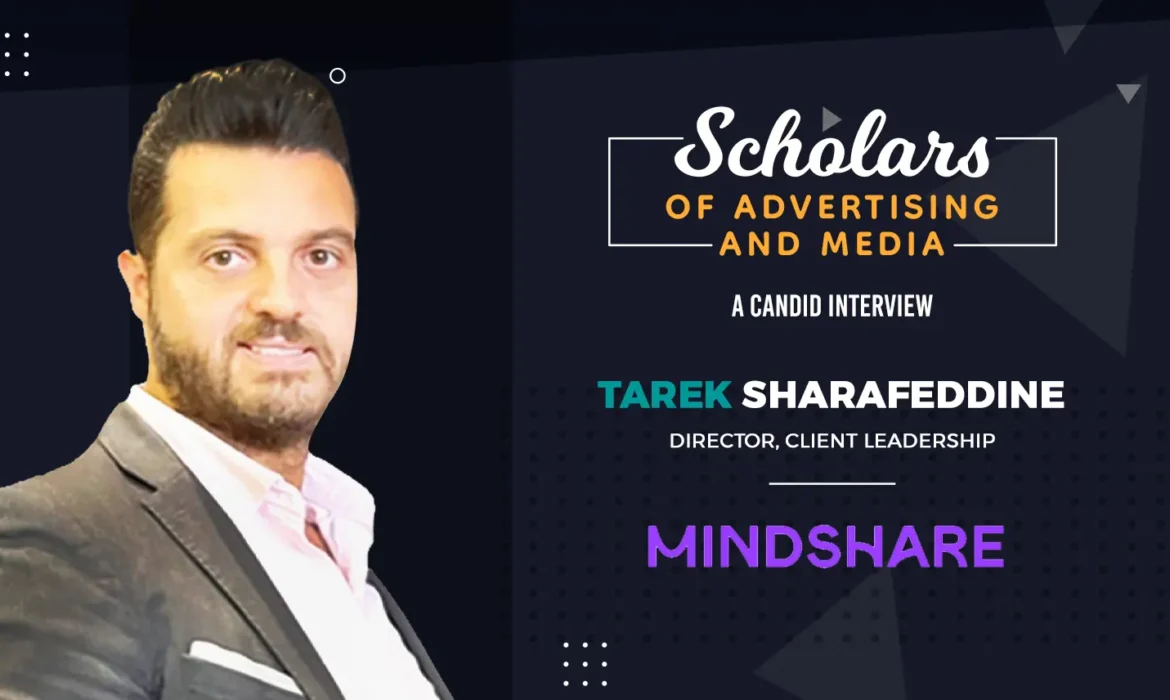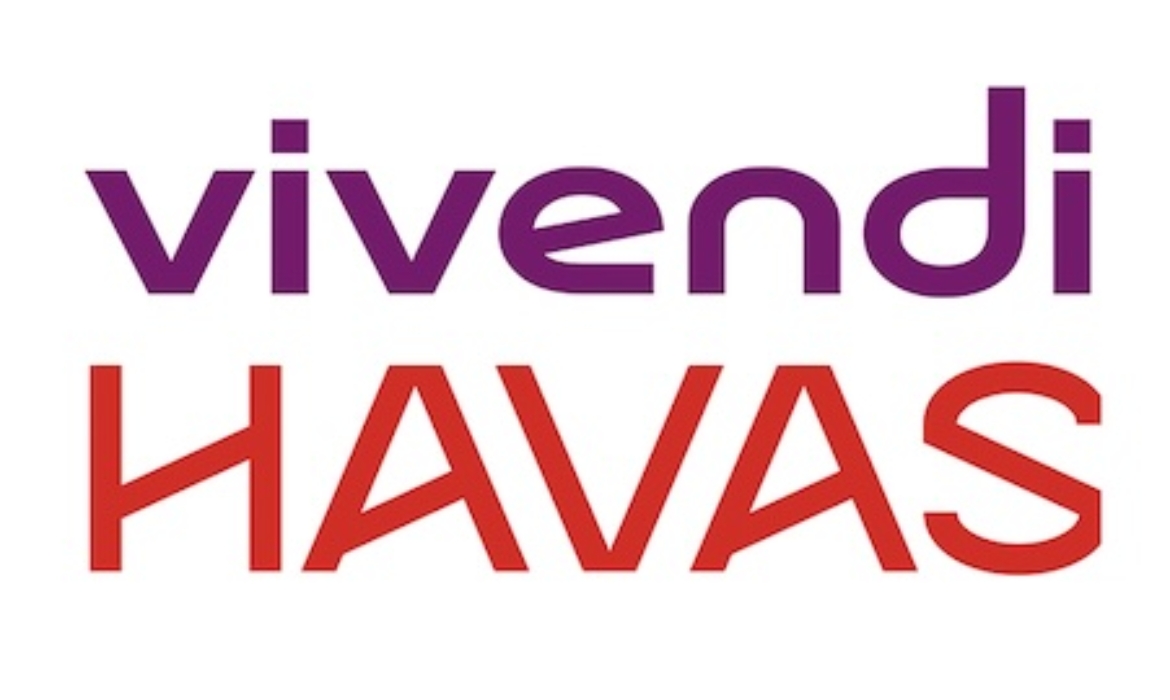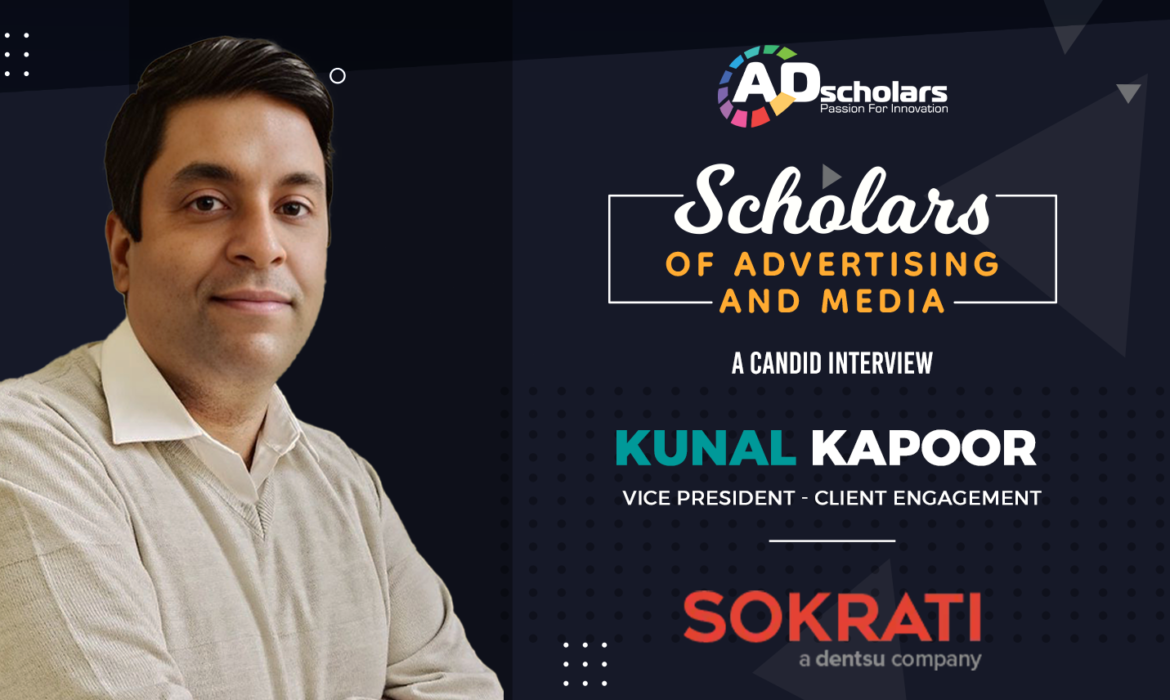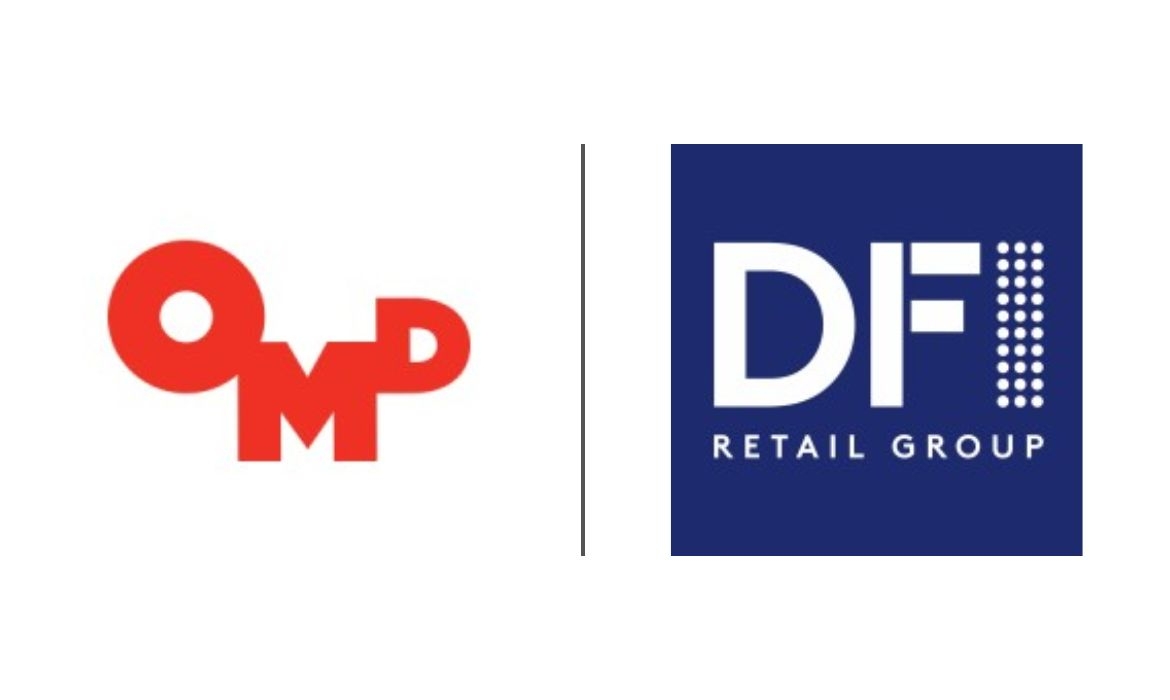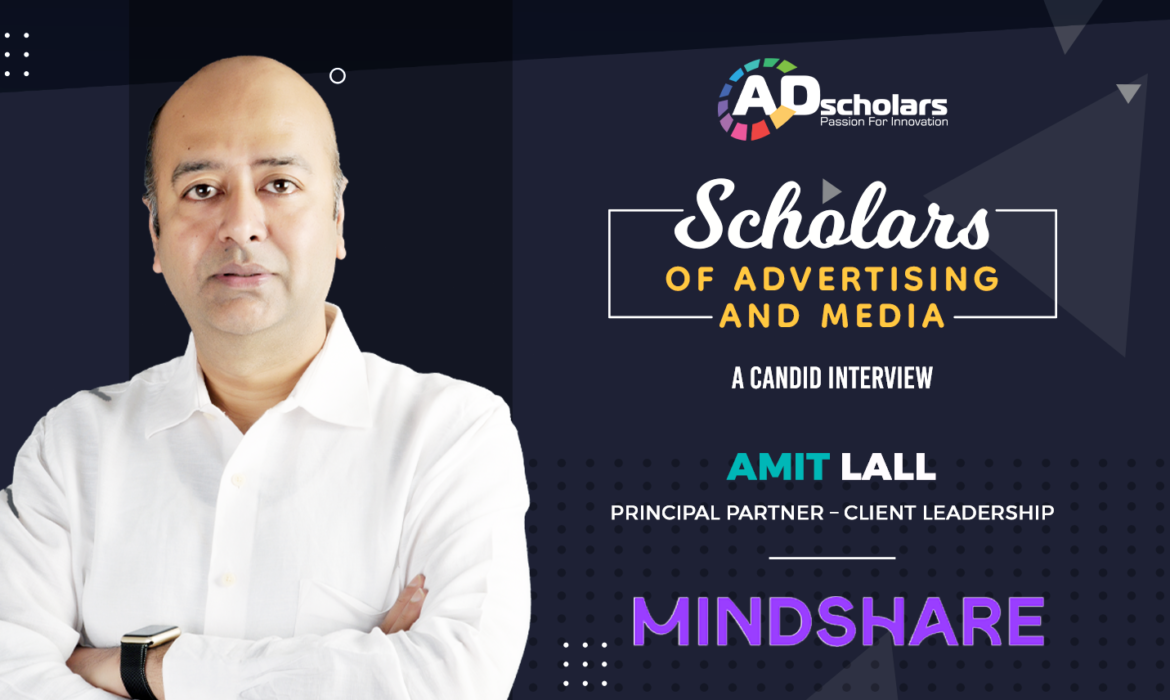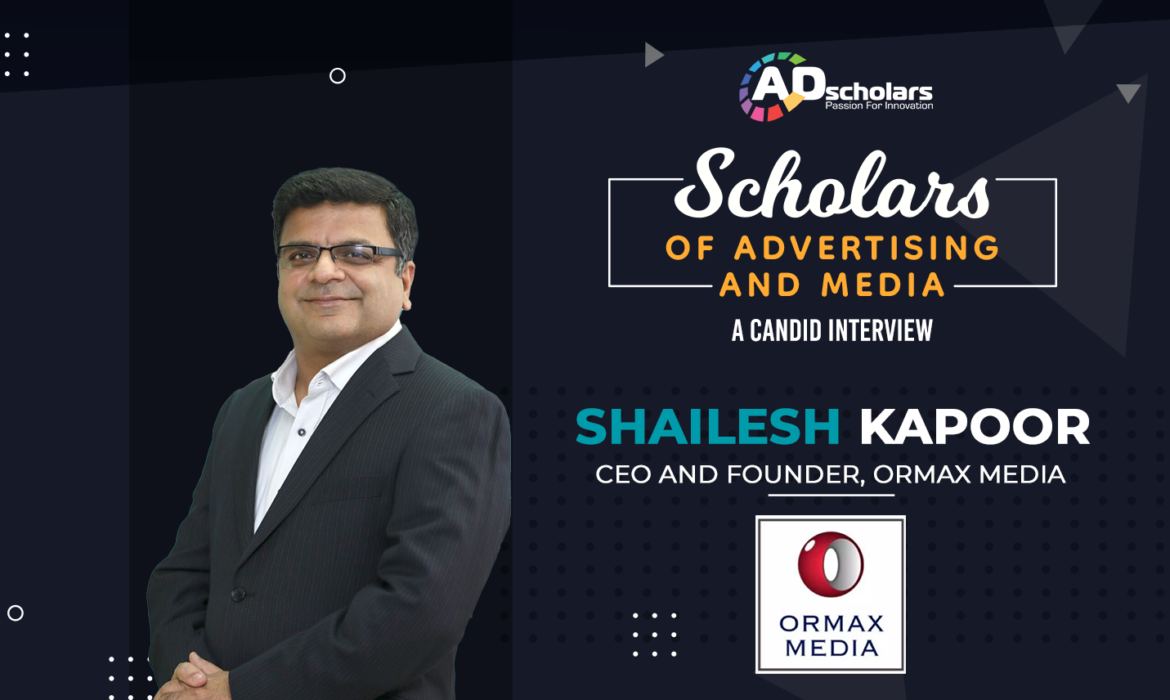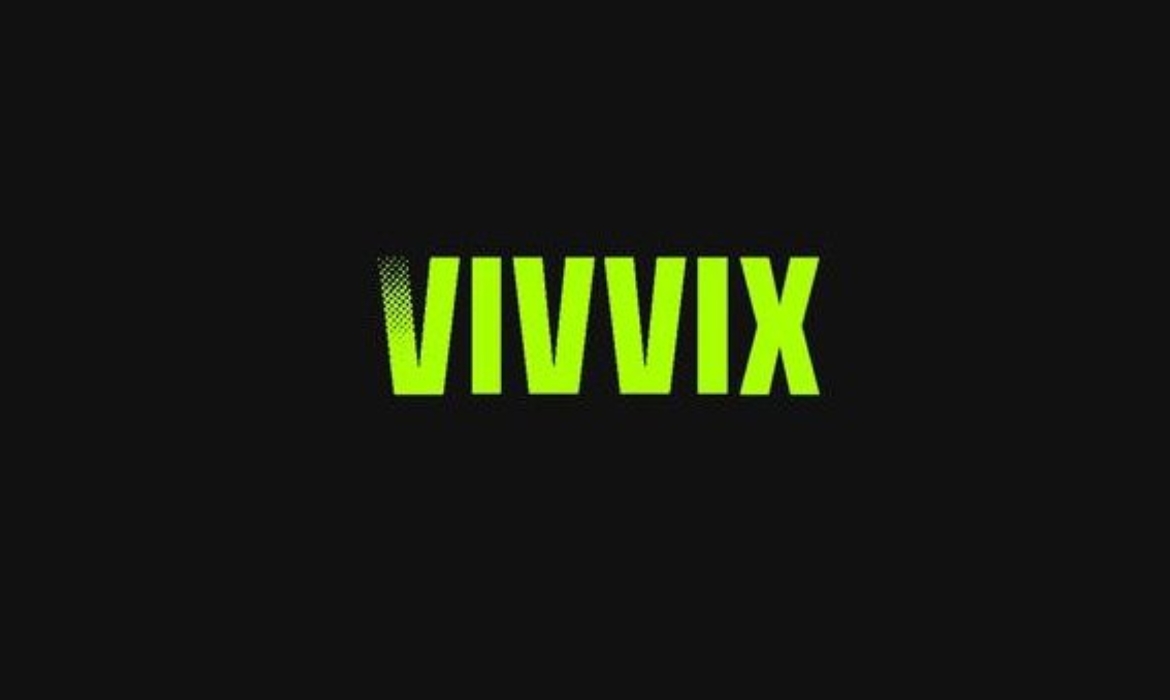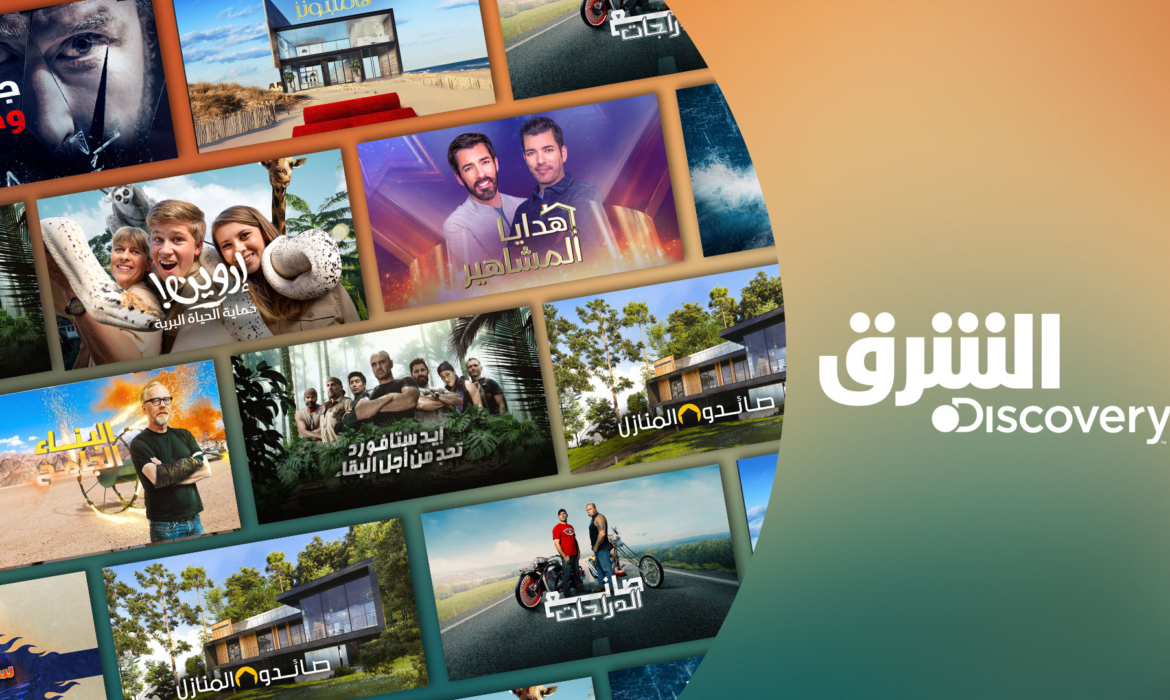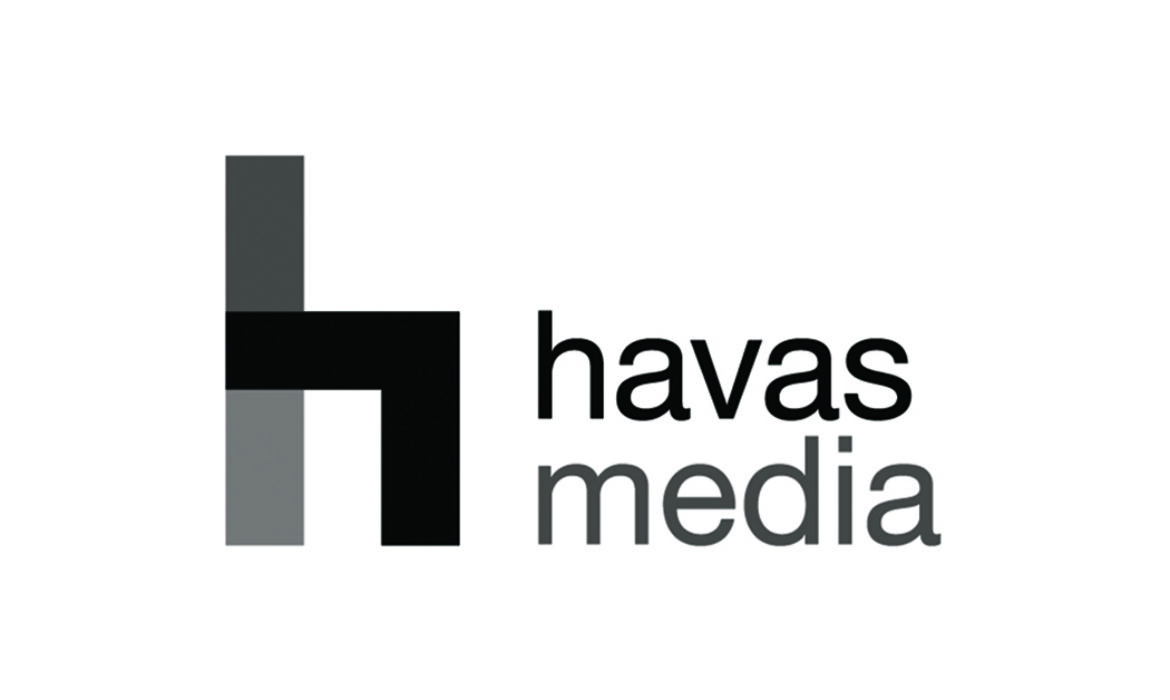Mindshare’s Tarek Speaks: Illuminating Media Innovations Amid Saudi Arabia’s Evolution
Tarek Sharafeddine, the Director of Client Leadership at Mindshare, brings 15 years of dynamic experience in the media industry, he possesses invaluable insights. His impact spans various sectors, from Telecom to FMCG, where he employs a strategic approach focused on continuous learning, strategic partnerships, and creating customized media solutions for the distinct challenges of each industry.
In an exclusive and candid interview, he delves into the ever-evolving Saudi media landscape. His strategic expertise extends to comprehensive campaigns, fostering key relationships, and embracing the latest innovations.
In your 16 years in the industry, how have you witnessed the Saudi Arabian media landscape evolve, and what specific challenges and opportunities has this evolution presented?
The media and advertising landscape has undergone a transformative shift, largely influenced by the rapid adoption of digital technologies. Traditional media outlets, such as television and print, have faced challenges as online platforms gained traction. Social media platforms like Twitter, Instagram, and Snapchat have become integral to communication and advertising strategies. Additionally, Saudi Arabia has witnessed increased investment in local content creation and a focus on cultural relevance in advertising campaigns. The lifting of the ban on cinemas in 2018 has also contributed to a more diverse entertainment landscape, impacting how advertisers reach and engage with consumers.
Reflecting on your career, can you share an instance where your strategic relationship-building skills were instrumental in not just project success, but in fostering long-term partnerships?
I vividly remember receiving a call from a new client inquiring about a straightforward cost estimate for a small InMall campaign. While it could have been perceived as a routine request, we went the extra mile by securing a meeting with them. During the meeting, we thoroughly discussed the array of services we could offer to contribute to the growth of their business. Subsequently, we presented a comprehensive strategy complete with committed KPIs and additional value. Our aim was to ensure that this campaign not only became a prominent topic but also a success. Fortunately, our efforts paid off, leading to the successful negotiation of a three-year contract with a respectable budget.
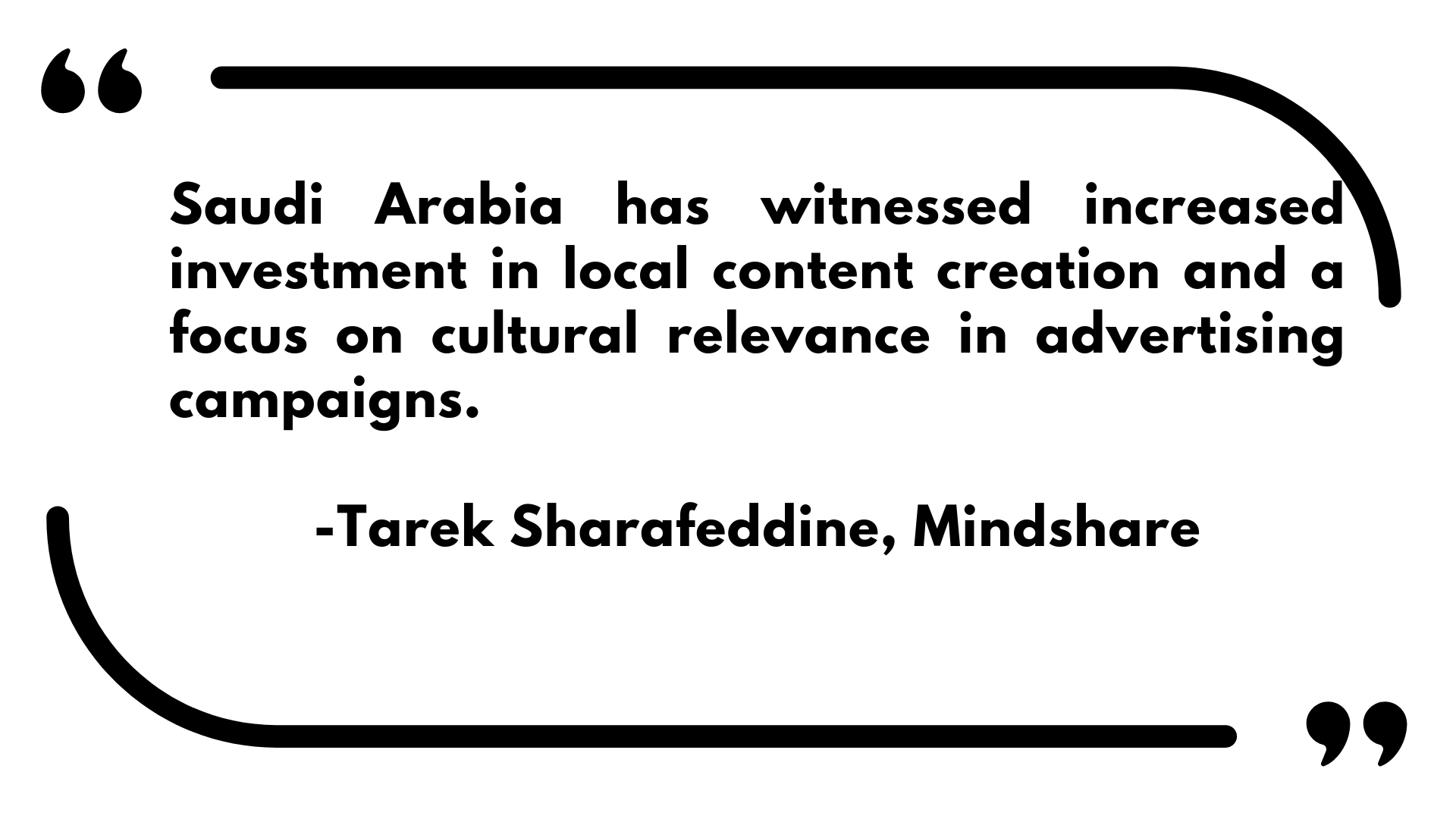
In working with Telecom, Governmental, Banking, Automotive, and FMCG, how do you customize media solutions for each industry?
Customizing media solutions for each industry involves a comprehensive approach to align strategies with the unique characteristics and challenges of the target sector. This begins with an in-depth analysis of industry trends, competitive landscapes, and regulatory environments. Audience personas are then developed, detailing demographics, preferences, and media consumption habits specific to
the industry. Content is crafted to be industry-relevant, incorporating sector-specific terminology and examples that resonate with the target audience.
Careful consideration is given to the selection of media platforms, tailoring distribution strategies to where the industry’s audience is most active. The tone and style of messaging are adapted to match the industry’s cultural norms, whether formal and professional or casual and conversational. Solutions are positioned as addressing industry-specific challenges, with integration into relevant events or
conferences to enhance visibility.
Collaboration with industry influencers and thought leaders is sought to boost credibility. Data analytics inform decisions, ensuring strategies remain effective and aligned with evolving industry dynamics and regulatory compliance. Continuous feedback collection and iteration based on insights gained contribute to the ongoing optimization of media solutions for sustained impact within each unique industry landscape.
Given the dynamic nature of the media industry, how do you ensure you stay informed about the latest trends and innovations? Can you share an instance were staying updated led to a strategic advantage for a client?
In addition to the pivotal role of connections and relationships in our business, active participation in conferences, events, and professional networks, coupled with subscriptions to key marketing trend sources, provides a significant advantage. This approach ensures early access to new products and beta versions, enabling clients to be pioneers in testing them. I’ve witnessed numerous instances where introducing clients to “first-time use products” resulted in remarkable outcomes, achieving nearly three times the anticipated key performance indicators (KPIs). This underscores the strategic importance of staying informed and leveraging innovations to consistently deliver exceptional value to
clients.
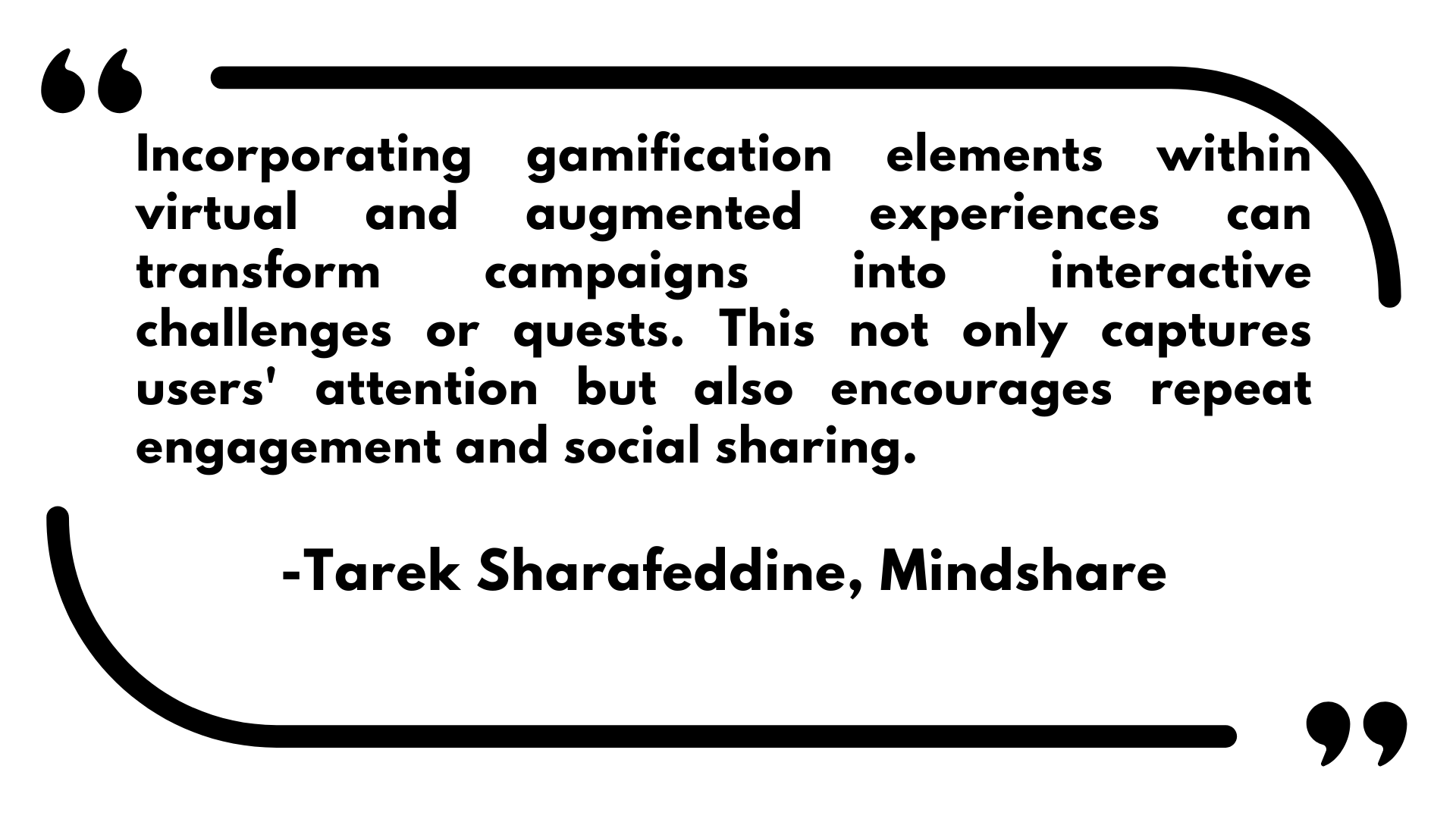
Can you highlight a particularly successful media campaign and outline the key strategies that made it successful?
We initiated a comprehensive full-funnel campaign, placing primary emphasis on achieving lower-funnel outcomes during the Ramadan period. Our approach to the brief involved meticulous identification of objectives and key performance indicators (KPIs), followed by a thorough analysis of the target audiences. This enabled us to tailor our media strategy for optimal reach and resonance.
Employing a multichannel strategy, we carefully selected a mix of traditional, digital, and influencer channels. This encompassed the utilization of multiple regional TV channels and a diversified set of integrated solutions, including sponsorships, special on-screen executions, and a compelling call-to-action for launching the offer. The call-to-action design incorporated multiple creatives,
specifically targeting different packages with varying commercial lengths.
To ensure effectiveness, we employed special solutions for tracking and optimizing the performance of each TV channel, sponsored program, and spot. Notably, we successfully measured the return of on-screen executions within a selected series on an active channel for the first time. Direct conversions in the lower funnel were measured, affirming the efficacy and efficiency of our new channel mix. This achievement translated into a 12.3% increase in website visits and a 12.7% surge in app downloads in the lower funnel. Additionally, our efforts contributed to an impressive 86% increase in awareness and a 29% boost in consideration in the upper funnel.
The strategic use of TV as a performance tool played a pivotal role in driving tangible results and high-quality traffic to the client’s website.
Given the rise of interactive and immersive technologies, how do you envision incorporating virtual experiences or augmented reality into future media campaigns to enhance client engagement?
Expanding on the incorporation of virtual experiences and augmented reality (AR) into future media campaigns, the potential applications are vast. For instance, virtual events and trade shows can provide immersive brand interactions, allowing attendees to explore virtual booths, attend product demonstrations, and engage in real-time conversations with representatives.
In retail, augmented reality can revolutionize the shopping experience by enabling customers to virtually try on clothing, accessories, or even visualize furniture in their own living spaces. Furthermore, incorporating gamification elements within virtual and augmented experiences can transform campaigns into interactive challenges or quests. This not only captures users’ attention but also encourages repeat engagement and social sharing.
The future of media campaigns lies in creating participatory brand experiences through virtual and augmented realities, aligning with evolving consumer expectations for more engaging and interactive content.
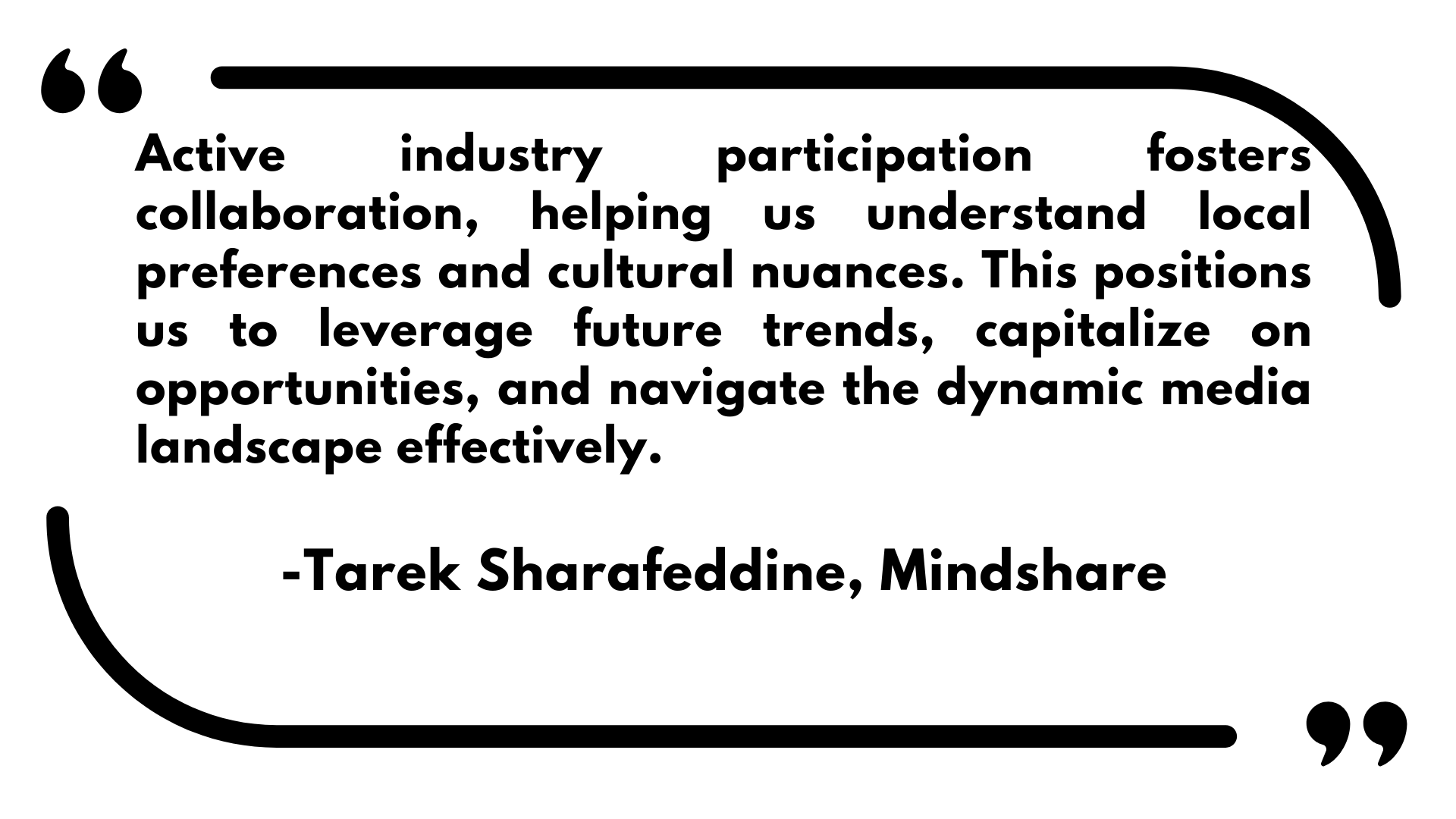
Looking ahead, how are you strategically positioning yourself and your team to adapt to the future trends and opportunities in the evolving media industry in Saudi Arabia?
To strategically position ourselves for the evolving media landscape in Saudi Arabia, continuous learning and skill development are paramount. We prioritize staying updated on industry trends, fostering a data-driven mindset, and embracing digital transformation, including emerging technologies like virtual experiences.
Actively participating in industry events and networks allows us to understand local preferences and cultural nuances, while encouraging collaboration within cross-functional teams. This holistic approach positions us to leverage future trends, capitalize on emerging opportunities, and navigate the dynamic media industry landscape effectively.
Havas May Become A Separate Entity As Vivendi Considers Three-Way Split
The share price of French media conglomerate Vivendi has surged. This is a result of its potential split into three distinct listed companies. In an attempt to increase the value of his company, French billionaire Vincent Bollore is considering dissolving his vast media and entertainment conglomerate, Vivendi SE. The plan calls for the roughly €10 billion ($10.9 billion) French conglomerate to be divided into three separate businesses: the Pay-TV division, Canal+; the advertising and communications branch, Havas; and a business that includes its majority stake in the publishing group, Lagardère Group.
Vivendi contemplates a three-way split
The company argues that this is because, as a unified entity, its shares are sold at a discount, which limits its capacity to carry out its intended expansion plan. The value of the various entities would be maximized by splitting them into three companies. Vivendi claims that splitting itself into three sections will allow it to fully realize the development potential of all of its operations. Each of its three business divisions is currently seeing rapid growth in the global market, which is accompanied by a wealth of investment opportunities.
Rise in revenue and profit valuations
Should the split proceed, Havas and Canal+, Vivendi’s primary revenue and profit stream, will be spun off as independent businesses. After separating from their parent company, this could result in valuations of roughly €3 billion for Havas and €6.1 billion for Canal+. Regarding its €1.3 billion ($1.4 billion) ownership of the former telecom monopoly Telecom Italia SpA, Vivendi is also exploring options.
Subsequently, the organization intends to establish a third publicly traded division as an investment firm. It would accommodate Lagardère and encompass additional listed and unlisted assets in media and entertainment firms. To investigate a possible split, Vivendi will consult its “usual” banks and advisors. Any strategy must benefit all parties involved and consider tax implications. The market valuation of the three distinct entities might be roughly 40% higher than their current valuation.
Read More: Havas Announces Majority Stake Acquisition in PR Pundit in India
Vivendi’s split from Universal Music Group
The news comes two years after Vivendi split from Universal Music Group in a highly successful IPO. This gave shareholders ownership of 60% of the company’s shares. The board is now permitted to investigate the possibility of dividing into three companies. Ad holding company Havas Group would once again become an independent publicly traded company if the plan is approved. This was the case until Vivendi purchased it in 2017.
It’s an indication of how Bollore, the industrialist and corporate raider who invested in Vivendi for the first time in 2011, is still shaping the organization. He is essentially leading even though he is no longer the chair. 2018 saw him fold into another business he owned, the advertising agency Havas, after first selling off his video game and telecom assets. At the time, he held just under 30% of the group’s shares.
Vivendi’s efforts for business synergies and cohesion
For a considerable time, investors and Vivendi have been frustrated by the group’s operating businesses’ lack of coherence and synergies. Since his father’s official retirement in 2022, Yannick Bollore has been working to make things better. Vivendi declared that it would evaluate the viability of the suggested split. It would take into account the tax implications for shareholders, in collaboration with banks and other advisors. There was no deadline given for finishing the assessment, but information will be shared “in due course.” The split plans were announced only a few weeks after Vivendi effectively acquired the rival Lagardère group, expanding its holdings to include publishing house Hachette.
Read More: Havas Acquires EPROFESSIONAL, a Hamburg-based Digital Performance Marketing Agency
Merkle Sokrati’s Kunal Kapoor: Charting Unseen Horizons in Digital Marketing
Kunal Kapoor, Vice President of Client Engagement and Delivery at Merkle Sokrati, a seasoned professional with 16+ years in Marketing, Sales, Business Development and Client Strategy, shares valuable insights in this exclusive interview.
He highlights the strategic alignment of campaign goals with business objectives and addresses ethical considerations in AI for digital marketing. His perspectives offer a comprehensive view of navigating the dynamic advertising landscape.
How has your extensive 15-year experience in the advertising industry shaped your illustrious professional journey? Could you share your background and noteworthy milestones that you encountered?
I earned my Masters in Business Management from BIT Mesra, Ranchi, in 2007, marking the commencement of my 16+ years of professional journey. In the first half of my career, I worked with prominent media houses and telecommunications giants such as HT Media, Jagran Group, and Tata Docomo. During this period, I learnt about B2C marketing, delving into the practical applications of the 4 Ps of marketing – Product, Price, Promotion, and Place. My expertise centered around new media, mobile marketing, and convergence marketing.
At the age of 28, I ventured into entrepreneurship, serving as the Chief Marketing Officer for a startup for nearly 5 years, specializing in mobile marketing. Following the downturn in the telecom industry in the mid-2010s, I successfully transitioned to core digital marketing. Over the past 3 years, I’ve been a vital part of Merkle Sokrati (dentsu India), leading the client engagement cluster for the large clients’ portfolio in my role as Vice President – Client Engagement.
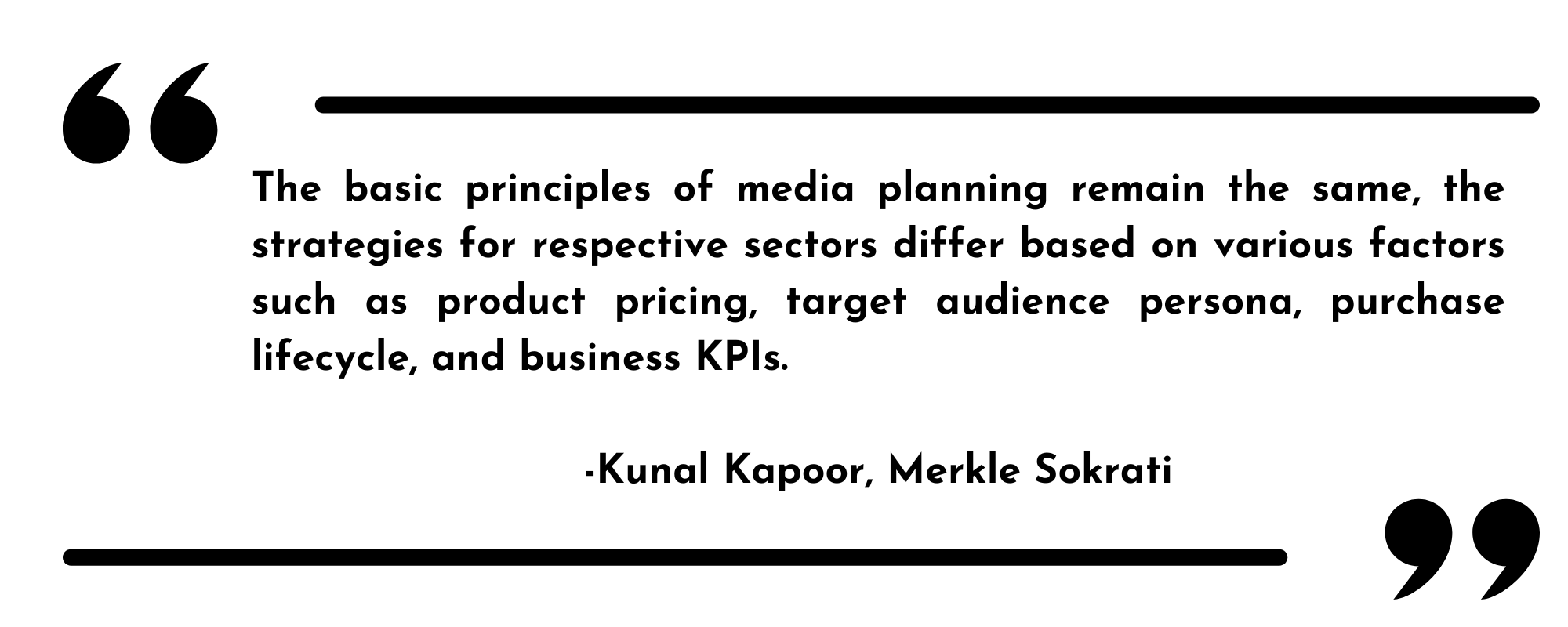
You manage a wide range of clients from Consumer Durables to EdTech to Healthcare. How do you align your strategies to vary with regard to different sectors and at the same time fulfil client objectives and expectations?
Although the basic principles of media planning remain the same, the strategies for respective sectors differ based on various factors such as product pricing, target audience persona, purchase lifecycle, and business KPIs. Taking these factors into consideration, the media mix and strategy are formulated with a comprehensive funnel approach – employing different strategies for different stages of the funnel: top (awareness), middle (consideration), and bottom (conversion). It also necessitates a clear definition of short-term and long-term business goals by the brand custodians. Without such clarity, the goalposts may shift unpredictably, potentially disrupting campaign stability and impeding sustainable growth.
Everyone is rushing to adopt AI in their businesses. What according to you are some of the ethical implications of using AI in digital marketing? How do you think AI will help in customer engagements and the marketing industry overall?
The ethical implications of AI in digital marketing revolve around principles such as fairness, privacy, and accountability. To ensure adherence to these principles, brands and agencies must actively work towards implementing ethical frameworks and establishing monitoring mechanisms. It is crucial for them to take responsibility for the potential impact AI can have on society and customers.
Despite these concerns, AI brings forth numerous benefits. It aids digital marketers in enhancing campaign accuracy by providing data-driven insights that are challenging to extract manually. Additionally, it contributes to increased productivity by saving time spent on mundane tasks like trend analysis and campaign optimization. This time-saving aspect allows digital marketers to focus on innovation, experimentation, and ideation.
Moreover, AI plays a pivotal role in deepening customer engagement through activities such as personalization at scale, personalized re-marketing, cross-channel targeting, and data-driven decision-making based on behavioral trends and funnel-level analysis.
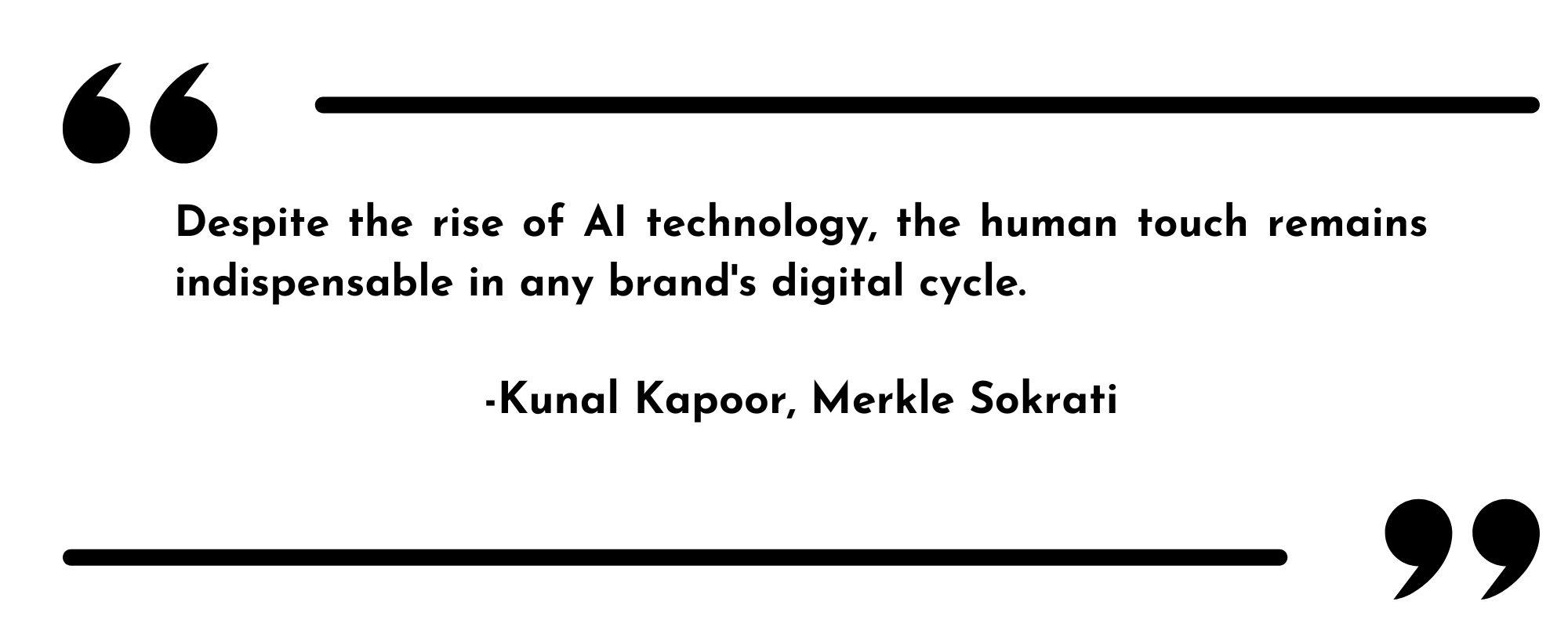
Adding on to the above question, with the rise of voice assistants like Alexa, Google Assistant etc., people are shifting towards voice search. Dentsu has been focusing on voice search assistant, or VSO strategies for geographical targeting. Can you tell us what are some of the strategies you use?
Voice search results differ from traditional search outcomes due to their conversational nature, focusing on answering specific questions rather than presenting a list of results. Consequently, Voice Search Optimization (VSO) requires a distinct approach compared to traditional SEO. At Dentsu, our VSO strategies concentrate on identifying relevant long-tail keywords for your business and seamlessly incorporating them into your website content. Key strategies include:
- Creating locally relevant content: Enhance your local voice search visibility by generating content tailored to local audiences.
- Claiming and optimizing business listings: Ensure your business information is accurate and up-to-date, maximizing visibility in local search results.
- Including natural language in content: Address common questions and concerns of local customers through the use of natural language in your content.
- Utilizing schema markup: Provide additional context about your website’s content to search engines, enhancing visibility in voice search results.
- Mobile optimization: Prioritize mobile optimization, considering that voice search is predominantly performed on mobile devices. This involves ensuring your website is mobile-friendly, optimizing website speed, and implementing responsive design.
Digital media is widespread in this time and age. How do you ensure maintaining the human touch while curating strategies? How important is it to have a human touch in the advertising realm?
Despite the rise of AI technology, the human touch remains indispensable in any brand’s digital cycle. The reason is machines excel at analyzing data and identifying patterns, but it’s the human touch that infuses creativity and emotions into digital campaigns and strategies. For instance, machines can adeptly track customer touchpoints based on call-to-action (CTA), but they can’t interpret how an audience is likely to react emotionally to an ad or a campaign.
Hence, the winning formula for any brand’s digital campaigns lies in emotion-driven content generation complemented by action based on data insights provided by AI technologies. We contribute flexibility and creativity to the digital world while interpreting changes in consumer behavior. In crafting campaigns for clients, we weave unique and original narratives designed to resonate with their target audience. By marrying data patterns with human input derived from consumer behavior, we ensure effective outreach to the right audience personas.
Can you share some examples of successful campaigns that you carried out at Dentsu? How did you implement key learnings in your future campaigns?
When a digital marketer engages in crafting a digital campaign, there are numerous factors and elements to monitor. These include, but are not limited to, audience targeting, marketing mix, creative assets, landing page design, user journey, and call to action. As campaigns unfold, they accumulate insights through data and platform algorithms. Our ongoing effort is to pinpoint the sweet spots—different combinations of the mentioned factors that prove effective for the brand in terms of scale and Customer Acquisition Cost (CAC). This iterative process allows us to build on successful elements, fostering sustainable growth for clients over months or years.
At Sokrati, we collaborate with leading brands across diverse sectors such as E-Commerce, Retail, BFSI, Automobile, and Fashion. Notably, for a prominent EV brand, our SEO best practices and innovative strategies led to the ranking of 100+ branded keywords in the 1st position on Google SERP within three months of launch. For a BFSI client, a major bank, we achieved a remarkable 314% growth in new account opens month on month, coupled with a 76% reduction in CAC. This success was attributed to full-funnel optimization, audience expansion, leveraging high-intent users, and continuous product enhancement.
Another noteworthy campaign involved a leading matrimonial brand, where the primary goal was to boost brand awareness and consideration through Programmatic Media and Display Campaigns. Through rich media formats, we achieved a 4.5x increase in engagement while simultaneously reducing CPCs by 65%.
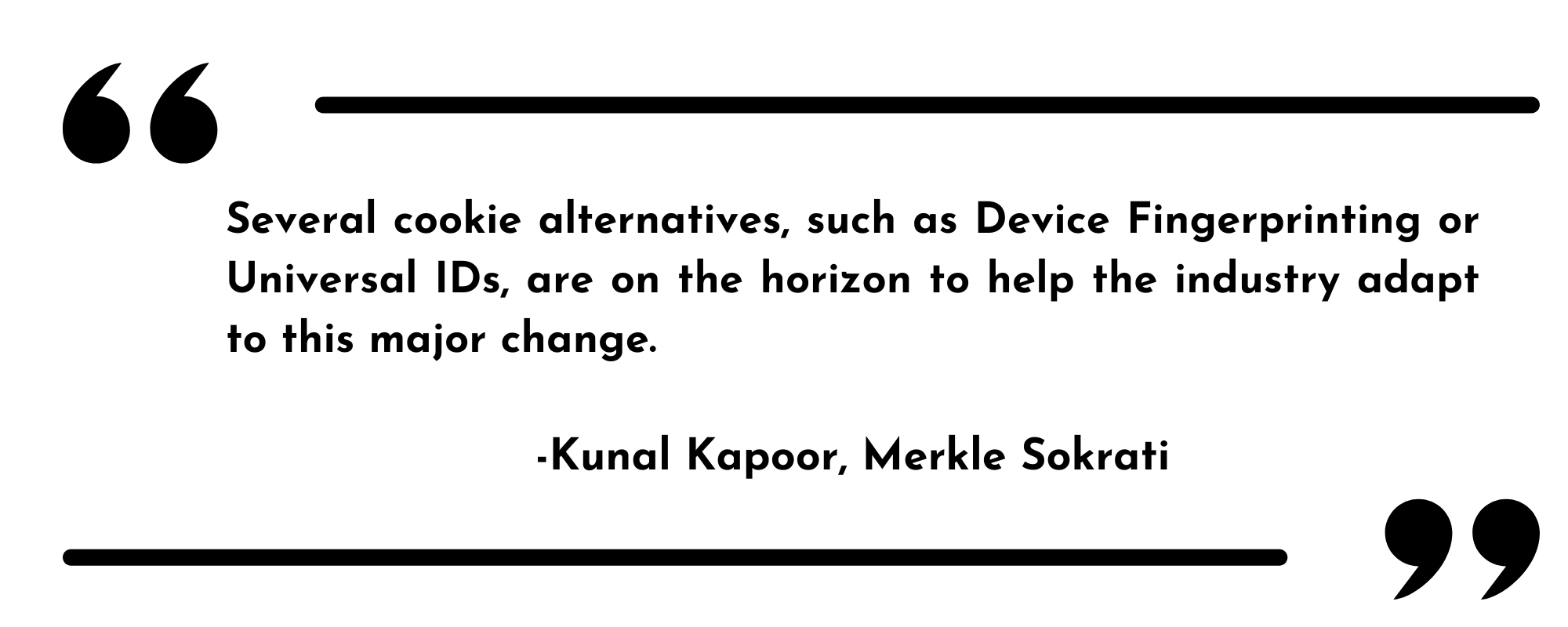
Google’s upcoming third-party cookies deprecation is set to drastically change the advertising landscape. What changes, good or bad, do you think it will bring to the programmatic and media landscape?
The absence of third-party cookies will make it challenging for advertisers to track and deliver targeted ads across the web. This could lead to less effective advertising and a potential decrease in the overall size of the digital advertising industry. Publishers will also face difficulties monetizing their websites as the ability to sell targeted advertising through cookies diminishes. In response, publishers will need to evolve and launch their own ad solutions.
Several cookie alternatives, such as Device Fingerprinting or Universal IDs, are on the horizon to help the industry adapt to this major change. Businesses relying on cookies for digital advertising will need to transition towards zero-party data to stay relevant in a post-cookie era. Zero-party data is information voluntarily shared by users with businesses, including preferences, interests, and contact information. It is more accurate, reliable, and privacy-friendly. With rich databases of first-party data, media companies and publishers will be well-positioned to succeed in a cookie-free world.
How do you determine the campaign’s effectiveness? What are the certain characteristics or key objectives that you look for?
Following the thumb rule, campaign goals align with the client’s business objectives. Campaign effectiveness is gauged by how well the strategy and results contribute to achieving the brand’s business goals. To measure campaign success, tracking interactions and conversions across digital channels is essential, attributing these conversions to the campaign.
Before diving into measurement, it’s crucial to define business objectives, establish campaign goals and targets, identify the target audience, and set Key Performance Indicators (KPIs). Common KPIs include Conversion Rate, Unique Visitors, Bounce Rate, and Page Views. The campaign’s outcomes are then tracked and measured using robust analytics tools like GA, AMC, HubSpot, etc.
OMD Defends its Media Responsibilities for DFI Retail Group in APAC
Multinational advertising company OMD has effectively defended its media account for DFI Retail Group, a major pan-Asian retailer with locations in Singapore, Malaysia, Indonesia, and Hong Kong. After a competitive pitch, the agency will continue to handle its media responsibilities in APAC. The account, which is valued at almost $40 million, covers DFI’s subsidiary brands, including Mannings, Ikea, and Cold Storage.
OMD’s Media Duties for DFI Retail Group
During the pitching process, OMD was up against Mindshare, Dentsu, Publicis, and Mediabrands. With $1.2 billion in billings from 122 accounts, the agency led the global advertising agency rankings for new business activity from January to August 2023. This year, the agency has been extremely successful. In 2019, DFI Retail gave OMD its media mandate for the first time. Most recently, Bacardi, a spirits company, awarded OMD the global media account. After a competitive review, British fashion house Burberry also selected it in December 2022 to handle its worldwide media planning and buying responsibilities.
Read More: Amazon Ads and IPG Mediabrands Ink 3-year Deal for Upcoming Prime Video Ads
OMD’s recent wins
One of its most recent victories was the $187 million global account for the biggest privately held spirits company in the world, Bacardi. Nevertheless, OMD also lost many significant accounts. For instance, the $30.8 million French spirits brand Remy Cointreau in China. Another account was the $6.7 million Australian pharmaceutical company (a confidential client).
DFI Retail Group Collaborations
However, DFI Retail Group awarded M&C Saatchi Singapore a three-year contract with a one-year optional extension. The contract covered both Singapore and Malaysia in October 2022, capping their regional social pitch. DFI’s account in Malaysia will be managed by M&C Saatchi Malaysia. M&C Saatchi Malaysia and Singapore will collaborate to handle the work under the two verticals of digital strategy and creative for DFI’s SEO, social media, and electronic dance music initiatives. The account is already under work.
Read More: Wavemaker Defends the Media AOR For L’Oréal in Thailand
In Conversation with Mindshare’s Amit Lall: Mastering Digital Dynamics
Amit Lall, Principal Partner at Mindshare, brings two decades of expertise in telecom, technology, and digital planning. He oversees digital strategies for diverse sectors, prioritizing consumer-centric solutions powered by data.
In this exclusive interview, his insights will unveil the evolving media landscape, technological adaptations, and future trends, offering readers a glimpse into transformative digital initiatives propelling clients to sustainable success.
As an accomplished expert with over two decades of experience in this industry, can you walk us through your background and your experience working as the Principal Partner / Digital Lead – Client Leadership at Mindshare?
Mobile and technology have been my lifelong passions. I embarked on my professional journey with the telecom industry, initially in sales and later transitioning into product management, eventually finding my way into the realm of digital planning. This path has been characterised by a multitude of highs and lows, each contributing to my growth. Presently, I serve as a Principal Partner at Mindshare, where I oversee digital for West 1 cluster. The continually evolving digital landscape, coupled with the increasing influence of cutting-edge technologies like AI and ML, ensures that my work remains both exhilarating and challenging.
A wide range of clients come under your wing, from Fintech to Telecom to Fashion. How do ensure that the strategies employed for these sectors resonate with the specific audiences? Are there different digital strategies for each of them and if so, how do they differ from each other?
In the ever-evolving realm of brand management, a one-size-fits-all solution is elusive. Crafting effective strategies relies on a meticulous understanding of the specific objectives tied to the media task at hand. Our approach is tailored to align with the unique goals each brand aspires to achieve. Throughout the formulation process, we prioritize understanding the brand’s position in the consumer funnel. Whether the brand is emerging, established, or grappling with low consumer consideration, recognizing the brand’s needs is vital. We require absolute clarity on these points before delving into the realm of solutioning.
Furthermore, comprehensive details on the brand, its category, and its competitive landscape are indispensable. The better we know your brand, the more refined our solutioning becomes. These insights play a pivotal role in shaping communication and deployment strategies. Our solutioning is focused on an an audience-first approach, supported by robust data, powerful insights, and compelling content. By addressing these critical questions and staying committed to an audience-centric approach, we ensure that our solutions are not just effective but also resonate with the core essence of the brand.
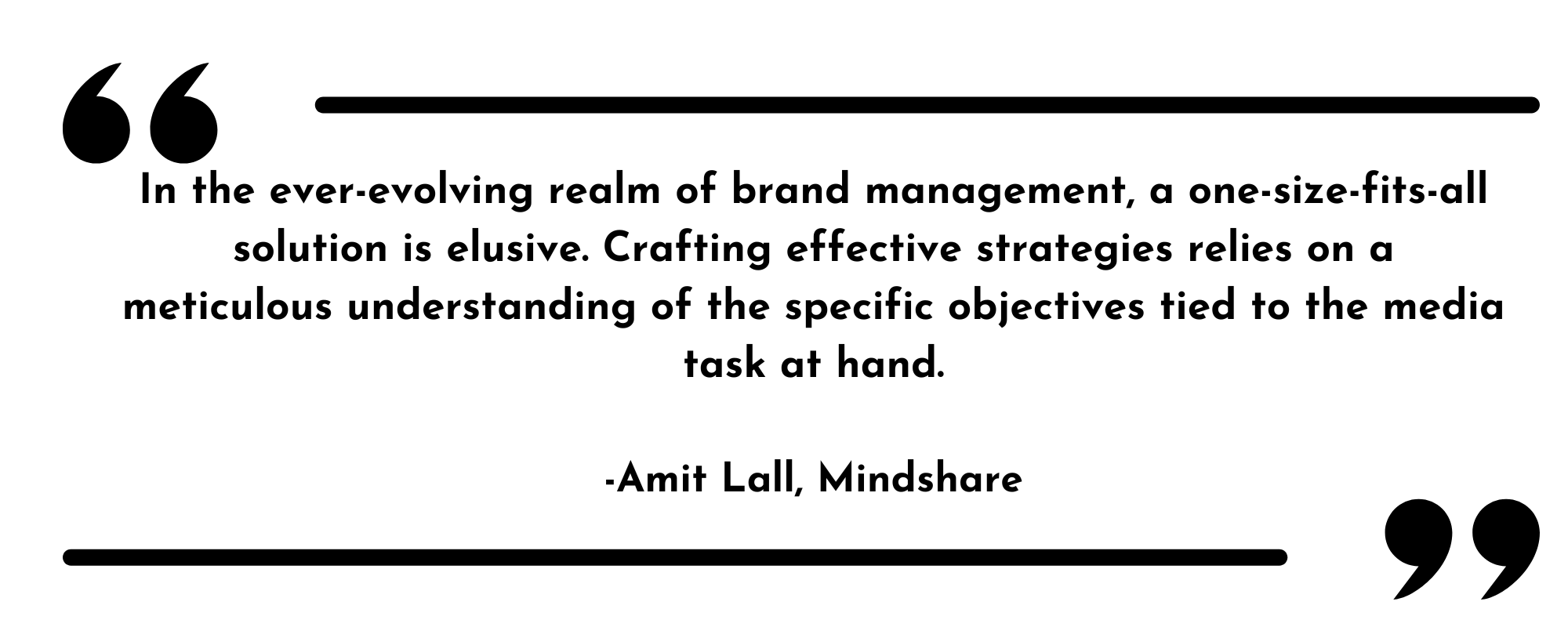
In the context of cutting-edge technologies such as Generative AI, Metaverse, and 5G, how have you prepared yourself to embrace them? How have they disrupted the advertising industry?
To be transparent, navigating the multitude of changes in the tech space, whether in Generative AI, the Metaverse, Blockchain, or Web 3.0, can indeed be challenging. However, working in the digital industry provides a unique advantage, offering exposure to numerous startups and tech enthusiasts. This exposure allows firsthand experiences with technologies and helps understand their true potential, which can be leveraged for user experience, engagement, and performance enhancement.
At Mindshare, we’ve always championed the ethos of leveraging technology and staying at the forefront for our clients. These cutting-edge technologies are seamlessly integrated into our tactical deployment strategies, contributing significantly to our client’s success by delighting their consumers. A testament to this commitment is our pioneering adoption of the Metaverse for clients in the auto and beverages categories. Additionally, we boast numerous success stories stemming from the strategic deployment of AI/ML tools, resulting in superior media outcomes that have played a pivotal role in driving growth for our clients.
Your 20 years of experience in this industry must have given you a unique perspective on the changes and evolution of this industry. Do you see any emerging trends? What preparations do you have in place to face them?
Over the past two decades, we’ve witnessed a remarkable transformation in the media landscape. What was once at the periphery of media choices is now inching towards dominating it. The sheer scale and technological advancements in the digital realm have not only propelled its growth but also led to a significant reshaping of budget allocations. Digital media is not only growing but also taking money away traditionally allocated to TV through connected TV, OOH through DOOH, and radio through streaming music apps.
With continuous push and support from the government, digital penetration is at an all-time high. This has translated into massive adoption of smartphones, complemented by cheap data plans to drive usage and high-speed connections across 4G and 5G networks for a superior experience. As these factors converge, we foresee our future trends being dominated by big query data, driven by the prowess of Generative AI and ML.
AI and ML are not only about automation and predictive analysis but also about multiple messaging or personalization at scale. The adoption of Connected TV (CTV) is poised to outpace growth projections at an accelerated pace. Furthermore, we anticipate that full-funnel deployment will become the new norm, as advertisers seek comprehensive strategies covering every stage of the consumer journey. Lastly, I believe retail media will continue its dominance, reflecting the evolving dynamics of consumer behavior and preferences.
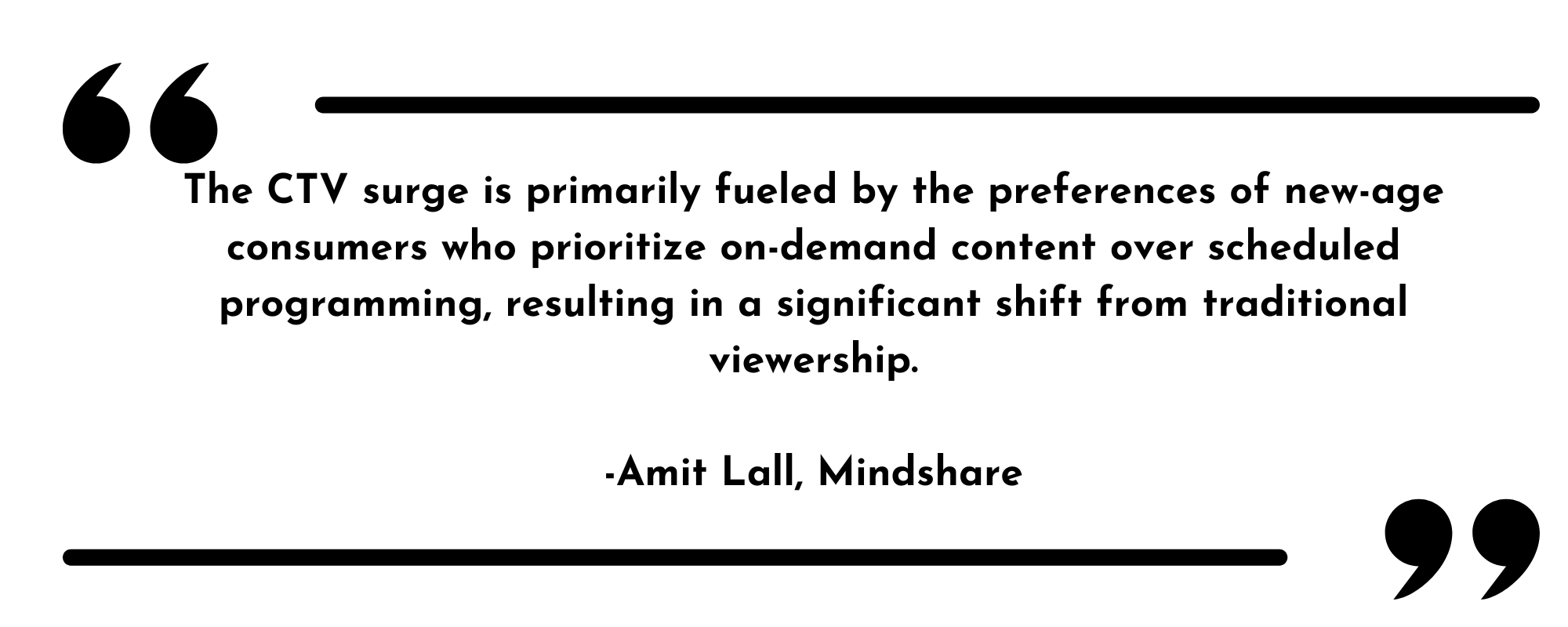
Consumer viewership habits have also evolved over the period of time. What metrics and goals do you look to accomplish for CTV vs Mobile advertising? Can you throw some light on the CTV advertising landscape in India?
India’s CTV ecosystem is experiencing unprecedented growth, reaching 33 million households in July 2023, a substantial increase from the 11-12 million recorded in January 2022. Projections from the GroupM Finecast report suggest a trajectory toward 50-60 million households by the end of 2025. This surge is primarily fueled by the preferences of new-age consumers who prioritize on-demand content over scheduled programming, resulting in a significant shift from traditional viewership. The convenience of accessing content anytime, anywhere has prompted a surge in viewers cutting the cord and embracing CTV. For advertisers, the appeal lies in the larger screen and premium ad environment, translating to a more impactful reach, with key metrics centered around impressions, viewability, and overall reach.
Digital marketing is a rapidly evolving landscape in which, Programmatic digital out-of-home (pDOOH) seems to be the new trailblazer marketing strategy everyone wants to undertake. What are your thoughts on this?
Digital OOH has changed the role of the OOH medium. From just being a ‘reminder’ medium, DOOH has also made it a medium to enhance imagery. The OOH industry has historically grappled with challenges related to transparency and measurement. However, with the emergence of pDOOH, both of these concerns are being addressed. Unlike the static-only medium, pDOOH provides a plethora of options, allowing you to play with formats such as video, staticads, and GIFs, enabling sharper targeting, and in some cases, even retargeting your consumers. These possibilities make this medium more effective.
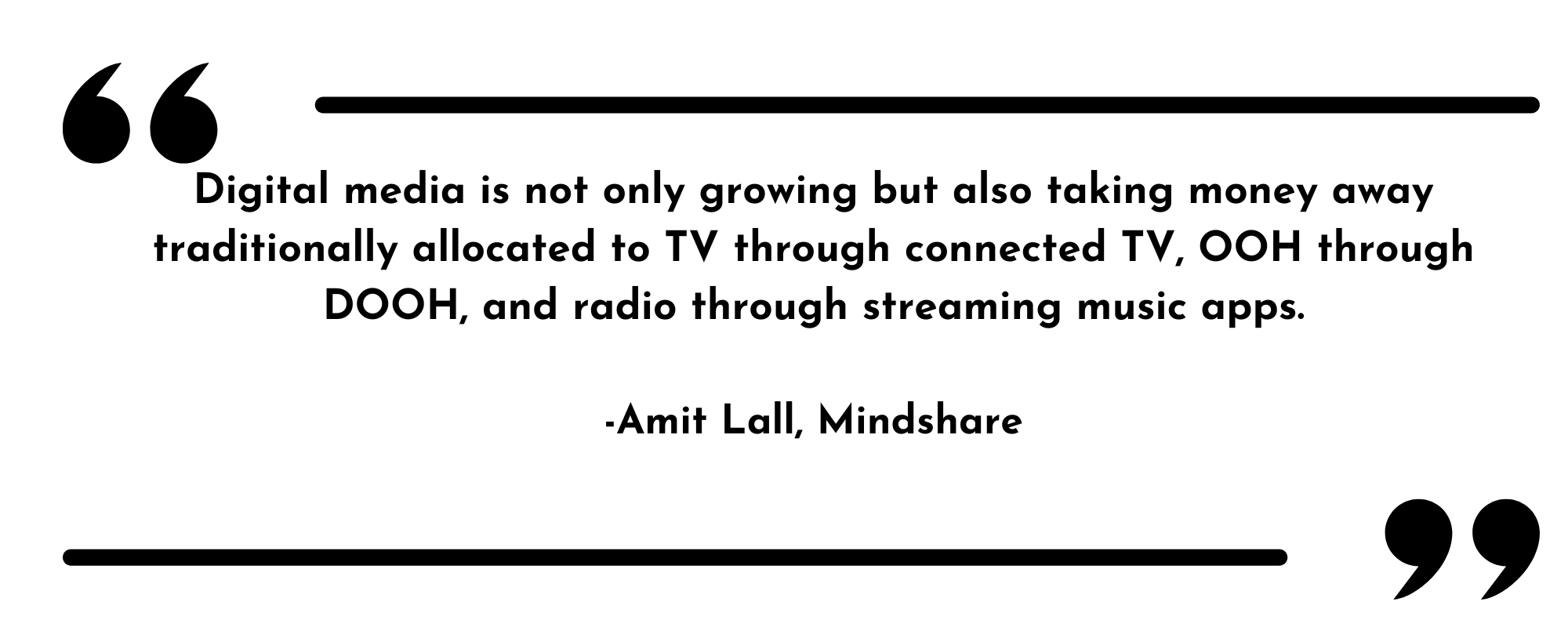
Have you ever run a marketing campaign that presented an unexpected challenge or outcome? How did you implement the lessons learned?
All campaigns are unique and designed with business objectives in mind. Based on the objectives, our solution isalways consumer-centric, powered by data. To drive engagement, we use dynamic creatives at scale, keeping the consumer’s journey in mind.
Any words of advice you would like to share with the young professionals about navigating through the ever-evolving marketing landscape?
My advice to young professionals is to stay curious and keep upskilling to adapt and stay relevant in the ever-changing media landscape.
Decoding Media Evolution with Shailesh Kapoor of Ormax Media
Shailesh Kapoor, CEO of Ormax Media, brings two decades of expertise to the Indian media industry. In this interview, he discusses the industry’s evolution, emphasizing the role of audience data and analytics at Ormax Media.
He sheds light on successful marketing strategies and the impact of influencer marketing in India. Discover how his insights and Ormax Media’s innovation collectively shape the industry, offering consumer-centric solutions and steering the future of media.
Having worked in media, TV, and marketing for more than two and a half decades, can you share your insights and your experience over the years?
The Indian media industry was in a fairly nascent stage when I started working in 1999. Over the last 25 years, there has been significant growth, especially with the digital medium coming in over the last decade. This growth has also attracted global players to India, bringing in best practices and processes. Yet, the Indian entertainment industry remains unique, relying equally on its chaotic energy and remaining instinct-led in large parts. One of our biggest challenges at Ormax Media has been to educate the industry about the value of audience data and analytics for more informed business decision-making. This remains a work in progress, especially in the South markets, where entertainment businesses are run in a more traditional way.
Viewership habits have changed amongst the Indian audience over the years. As a seasoned expert who has witnessed the evolution first-hand, can you shed some light on today’s viewership behavior?
Each medium has its unique role in the life of the viewer, and the viewing behavior of that medium reflects that. For example, television is the family medium, allowing families to spend quality time together every night—an essential need even more pronounced in today’s digital age. Despite the decline in appointment viewing, which was once crucial for television, there’s a noticeable shift amidst shorter attention spans. Surprisingly, the decrease in appointment viewing hasn’t resulted in increased channel flipping, as viewers prefer sticking to familiar shows and channels. In this evolving scenario, the Holy Grail of television has shifted from appointment to destination, emphasizing the channel’s significance over specific time slots in the competition for viewership share.
OTT is a medium for solo consumption or with those of the same group (spouse/siblings). Hence, it’s a more personal and intimate medium. Movie-going is an outdoor activity, equally about the social and communal experience as it is about the content itself. With the advent of digital media and the manifold increase in media choices available to the audience, including social media, viewing behavior is highly distracted. Anything that cannot hold the attention of the viewer for a few minutes will be rejected.

Social media and digital media have become increasingly popular, but they have also brought with them the rise of fake news and misinformation. What are your thoughts on this? Has this shift from traditional to digital been the primary cause of declining news credibility? If so, how can we combat it?
A lot of digitally savvy audiences still use print and television to ‘verify’ the news they see on digital/social media. That is the nature of online news: It will be high on immediacy but suspect on credibility. Building a credible news platform digitally requires one to build a strong brand, and this is where legacy brands, ranging from TOI to Jagran to BBC to Aaj Tak, have an advantage. One of the reasons TV news and print medium will continue to stay relevant is the credibility they bring in.
With the diversity of content available on these OTT platforms, people are shifting away from mainstream television. What is your perspective on advertising on these platforms? Would it help brands establish equity with their audience and reach the right audience?
Digital advertising, whether through platforms like YouTube or social media apps such as Instagram or Facebook or through AVOD apps, is on the rise. This is because a significant cohort of the younger, urban audience is consuming digital content more than television. Given that India is such a vast country with varied demographics, socio-economic groups, and geographies, both television and digital advertising will continue to be strong options for advertisers to choose from. The death of TV, as is often predicted, is a Western idea. In the Indian context, both mediums have a strong standing, and advertisers must choose the one (or both) depending on what fits the context, target audience, and messaging of their campaign.

There has been a tidal wave of influencer marketing in India, especially thanks to the popularity of Indian influencers. How do you think brands and advertisers can leverage influencer marketing in India to gain brand recognition?
The choice of the right influencer is important, because influencers may give reach, but don’t always ensure message credibility. Hence, brands must be careful in selecting influencers who are credible and fit the brand, and not just those who have the reach/ followers.
Can you take our readers through some of the methodologies you use to obtain industry insights? What are a few successful marketing strategies you have seen where advertisers took advantage of data insights from Ormax Media?
This is a vast topic, and we deploy a variety of methodologies, primarily in the areas of content testing, tracking media brands and campaigns, forecasting, and analytics. Our website has details of these methodologies for those interested in more information. Our work is primarily for media platforms (film studios, streamers, TV networks) more than advertisers. However, we work extensively with advertisers to help them choose the right media options and the right celebrity endorsers, among other services.
Our tool, Ormax Mpact, helps advertisers evaluate the success of high-impact brand activation, such as a big sponsorship or a roadblock. Our tool, Ormax Celeble, helps brands select the right endorser/influencer that fits the brand profile. We also have various industry reports that help advertisers understand the market size and growth of various sectors to build an outlook toward the sector’s health.
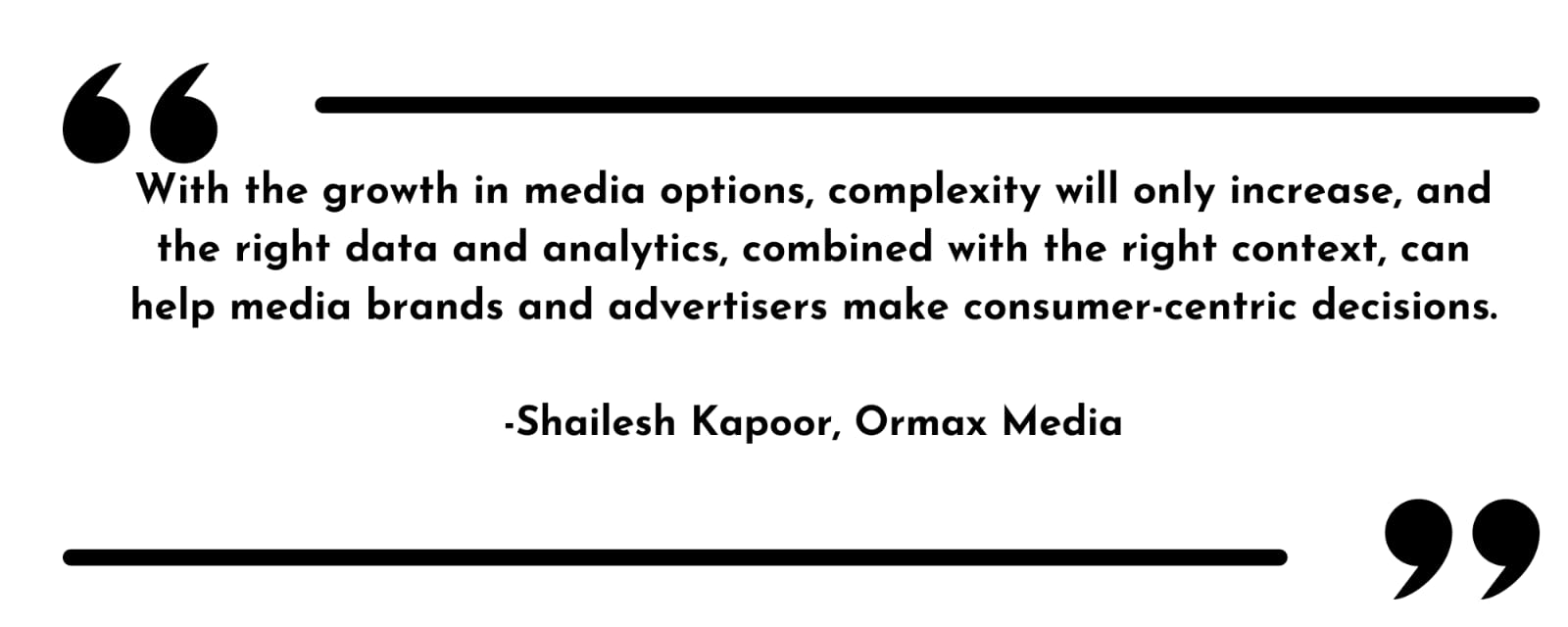
Are there any emerging or concerning trends you see in the future? How are you preparing yourself?
A definite trend that’s emerging is that the lines between different media are getting blurred. Today, Reels on Instagram are competing with long-format content like web series, for example. Yet, each medium and content type has its unique experience, making it relevant to its audience. A lot of our work post-pandemic is about understanding the nuances of media intersection. We do not buy into binary narratives, e.g., TV vs. OTT, OTT vs. theatres. Instead, our effort is to understand media intersection in the right context. For example, media choices of digital vs. TV for IPL will operate in a very different context compared to the audience’s decision to watch a new film in the theatre vs. OTT. With the growth in media options, complexity will only increase, and the right data and analytics, combined with the right context, can help media brands and advertisers make consumer-centric decisions.
Ameer Ismail’s Decades-Long PR Odyssey: Navigating a Dynamic Landscape
In the whirlwind world of PR, Ameer Ismail, President, Lintas Live, MullenLowe Lintas Group is the maestro orchestrating a symphony of success. Leading Lintas Live with visionary finesse, he’s transformed the game, turning campaigns into global resonances. Clients like Etihad and Starbucks are a testament to his strategic brilliance. Awards adorn his journey—CMO Asia, Reputation Today’s magazine’s list of top 10 PR leaders. Beyond boardrooms, he mentors and shapes the industry’s future. In the dynamic dance of communications, he’s not just rewriting the playbook; he’s setting the stage ablaze.
It was a pleasure to talk to him. Straight-forward, candid, and fair evaluations of the industry and business and great insights into the world of PR.
Your career trajectory within the group is quite dynamic. What principles have guided your career decisions and how has your leadership style evolved from Chief Growth Officer to President?
Firstly, a warm welcome to Lintas. I’m delighted to meet you. It’s been 27 years in the company and I’m not sure if it’s considered dynamic in this age of quick changes, but it’s certainly rare. Commitment, professionalism, and embracing core values—staying true to my profession and dedicated to the world of brands. These principles have been my anchor, keeping me in good stead throughout the journey.
I started as Associate Vice President when I joined the company in 1996, making me the youngest AVP in the company’s history. So, I’ve always held a senior role since day one, and there have been multiple other roles along the way. It’s been quite a trajectory!

Absolutely! What’s been the driving force behind your enduring commitment to this company over the years?
Lintas is an esteemed institution and continues to be one of the leading advertising and communications businesses. The roots of Lintas trace back over 75 years when it started as an advertising division of Unilever. The decision to diversify our offering stemmed from having a blue-chip client base primarily in advertising. Our management team led by former MD (and my boss at that time) Prem Mehta, envisioned offering clients newer and diversified services like PR. This strategic shift aimed to evolve the group’s offering and empower clients to build integrated campaigns. The PR brand (LINOpinion) came into the picture slightly before my time, around 1994. Back then, the PR landscape was small, both in terms of size and industry presence. Fast forward to today, and the scale of PR has grown tremendously, not just globally but also become significant in India.
You’ve pointed out PR has become quite huge now—could you share more, especially considering its substantial growth over the years?
To share perspective on this, globally, the largest PR agency generates over a billion dollars in revenue which is impressive, to say the least.
There are five major holding companies globally: Omnicom, Dentsu, WPP, Publicis, and IPG—we belong to IPG. These giants have multiple PR and advertising brands in markets all over the globe. The largest PR firm in IPG Weber Shandwick alone is also close to a billion dollars in revenue, surpassing some large global advertising networks. In essence, PR constitutes nearly 10 to 15% of the total advertising revenue globally. And it’s growing faster than advertising.
In your opinion, how has PR evolved over the years?
As things grow and evolve, they gain more significance in both business and visibility. Today, PR commands more respect than when I first started. I got into the business at an early stage as saw a chance for success and career growth then, and I still believe in the potential of PR. Now the game is specialist focus in PR with healthcare and pharma and technology focussed PR agencies that still have so much potential to grow.
Unlike advertising, PR campaigns don’t require large budgets and can create significant impact and there is the possibility of doing multi-market work or work for global brands while being based in India. For example, we manage clients in the Middle East, representing brands like Five Hospitality and Etihad Airways in the UAE. My vision for Lintas Live is to grow this space and create impactful global PR campaigns. We’ve taken many steps in this area and a few years ago we won a large global business – the Lagos Free Zone, in Nigeria. These are just a few examples of global brands and work.
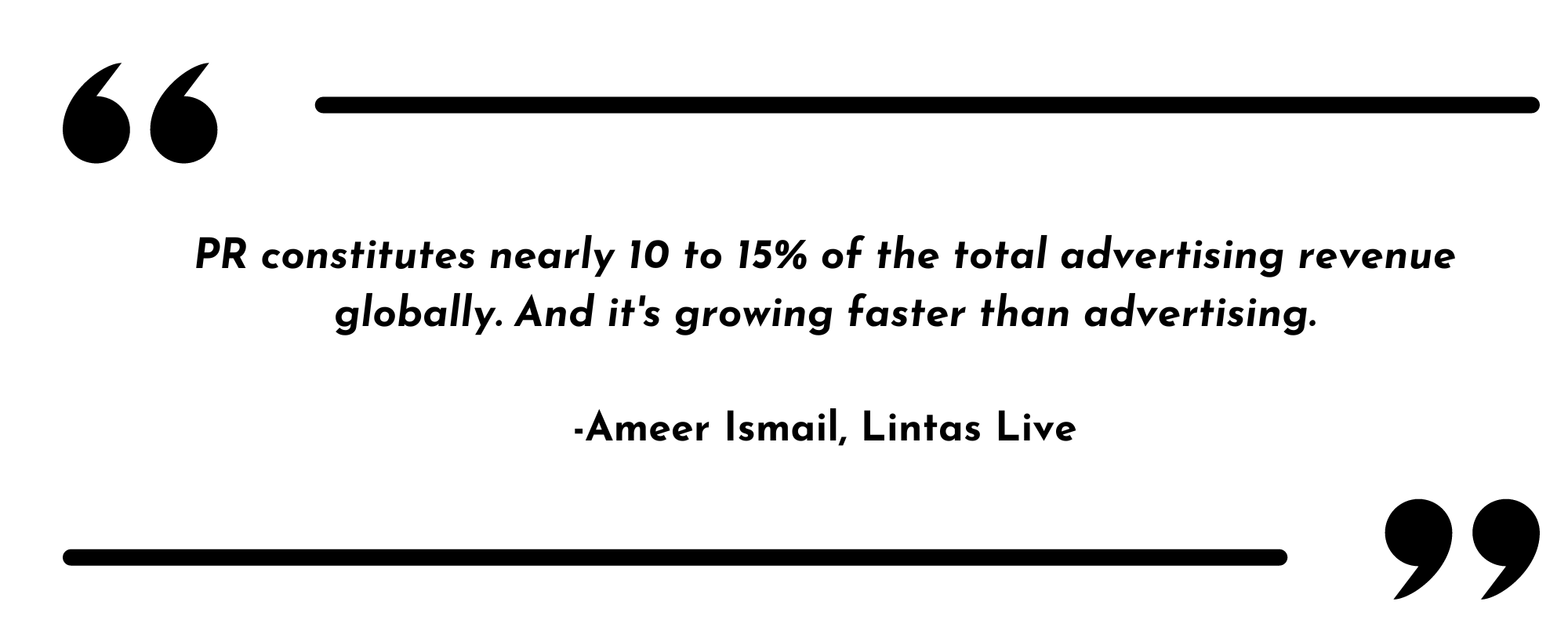
How do you see the distinction between PR for Indian brands and that for international brands?
Our creative capability, execution skills, and teams are best in class. We excel in producing global work from India, backed by world-class talent, and are known for generating brilliant ideas that are effective for our clients. I have also had the privilege of working with Golin, a top-ten global PR agency, and was a part of the global management team where I experienced the best of global standards in PR. The challenge in India is in the difference between intuition and insight. In evolved markets clients rely on data and research that gives you clear and sharp insights, while in India as clients are hesitant to invest in research and data driven insights. New-age PR campaigns even utilize behavioural science and AI and its predictive capabilities. It’s a constantly evolving and exciting landscape.
Is the growth of PR in brands now comparable to marketing and advertising, with similar budget allocations, or does it still vary?
No, it’s not similar budgets for PR, but it is improving as clients see more value. We focus on a certain value of business that allows us to deploy the best resources and refuse business below a certain level.
AI is gaining prominence. How do you envision AI technology transforming the field of PR and brand communications in the near future?
I expect AI to transform our business significantly and it starts with the incredible ability to research back data and then the capabilities to generate content so fast. However, I don’t believe that it can replace human intervention like creative ideation and can never replace depth of insight and ideas ingrained in our years of experience. Considering the prevalence of CGI ads, some clients opt for quick, budget-friendly solutions, but AI can never replace the human touch so even if one uses AI generated content, we make sure it is aligned to the brand DNA by oversight from our creative team.
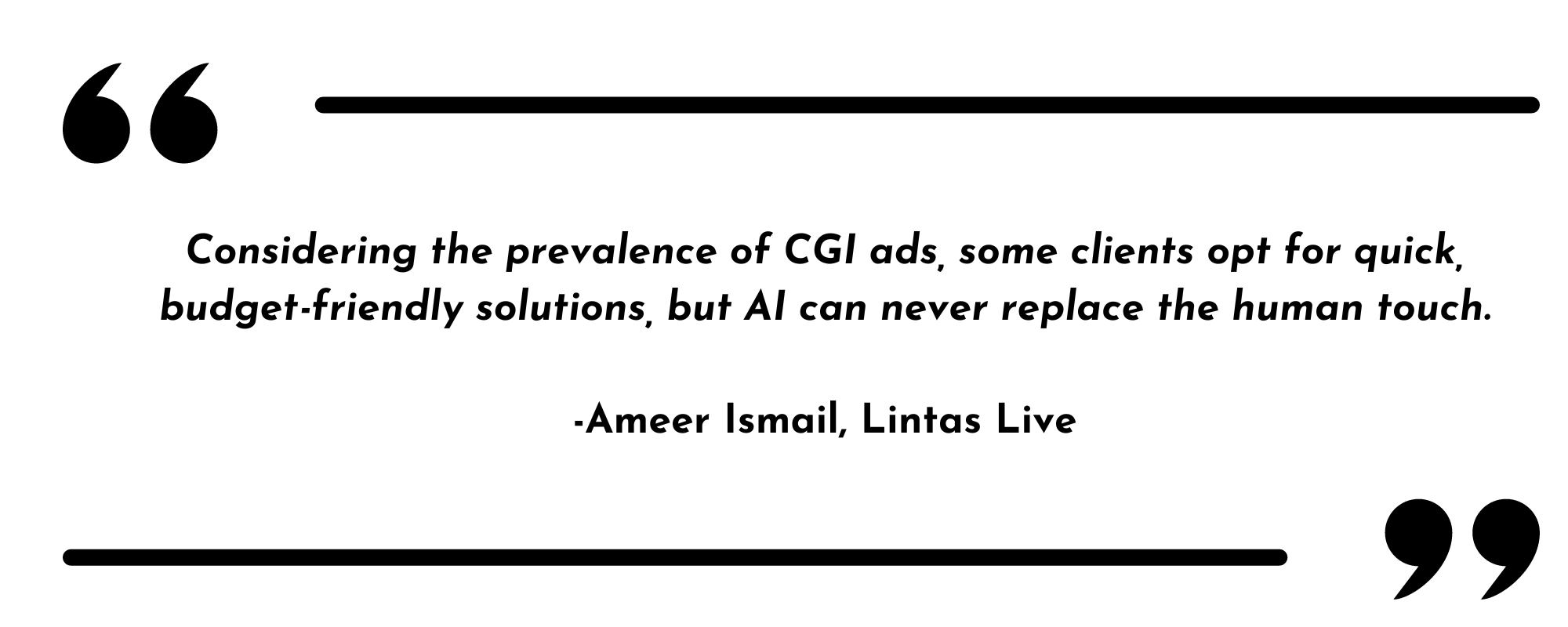
Can you share some examples of innovative PR campaigns or strategies that you have been involved in and their impact?
As an extension of its marquee campaign, H for Handwashing, Lifebuoy used the power of play this year and co-created ‘H for Handwashing Games’ with Imagimake to encourage children to adopt good hygiene practice. To help Lifebuoy take its social mission to the masses, we strategically leveraged owned, earned, and paid media to deliver the right message to the right audience. We drove thought leadership with HUL leadership, initiated regional media outreach, tapped into the social media platforms of media giants like The Times of India, Hindustan Times and Mad Over Marketing, and leveraged owned channels.
With this, we were successful in educating parents and caregivers across India about the importance of healthy hand hygiene and made them aware about how kids can learn about these essential hygiene habits through play. We also used different types of content including visual images, articles, and reels to further cater to the consumer’s content consumption preferences.
The campaign received significant traction among the traditional and new-age media platforms with media articles garnering a potential reach of over 150 million and reels garnering over 1.8 million views in less than a week.
Managing a global portfolio of clients requires a nuanced understanding of different markets. How do you tailor PR strategies to suit diverse cultural and regional contexts, especially in the case of international clients?
Traveling was the first thing I did when I was young, I took every opportunity to do this. I’m a big believer in exploring cultures as a best form of learning, and I push my team to do the same. Recently, a team member got the chance to visit Melbourne, courtesy of our long-standing client, Visit Victoria. Another colleague went on a media FAM to Singapore visit with one of our clients based there. These experiences give you a whole new outlook on life and culture, which is vital for understanding a global audience. You can’t get this knowledge solely from YouTube or Instagram reels.
Being recognized as one of the leading personalities in the PR industry comes with expectations. How do you stay ahead of the curve in terms of industry knowledge and innovation, and how do you encourage a culture of continuous learning within your team?
I recognize my strengths and long experience that have bought recognition, but I stay humble about my position in life. Incredibly proud of my achievements and am still enjoying my journey. I don’t measure success by others’ yardstick, there is always someone who seems to appear better, more successful. I believe you should be happy, positive, and committed to your own path in life.
Continuous learning is crucial—I listen/learn from colleagues every day and am involved with industry leaders, agency heads and some associations to further the development of the industry. Currently, I am involved with PRCAI to improve the win rate of Indian PR agencies in Cannes. There are learning sessions that aim to upgrade thinking for Cannes-worthy campaigns. I also encourage continuous learning with all teams and our HR team helps with an active learning program that provides training across all levels of the company.
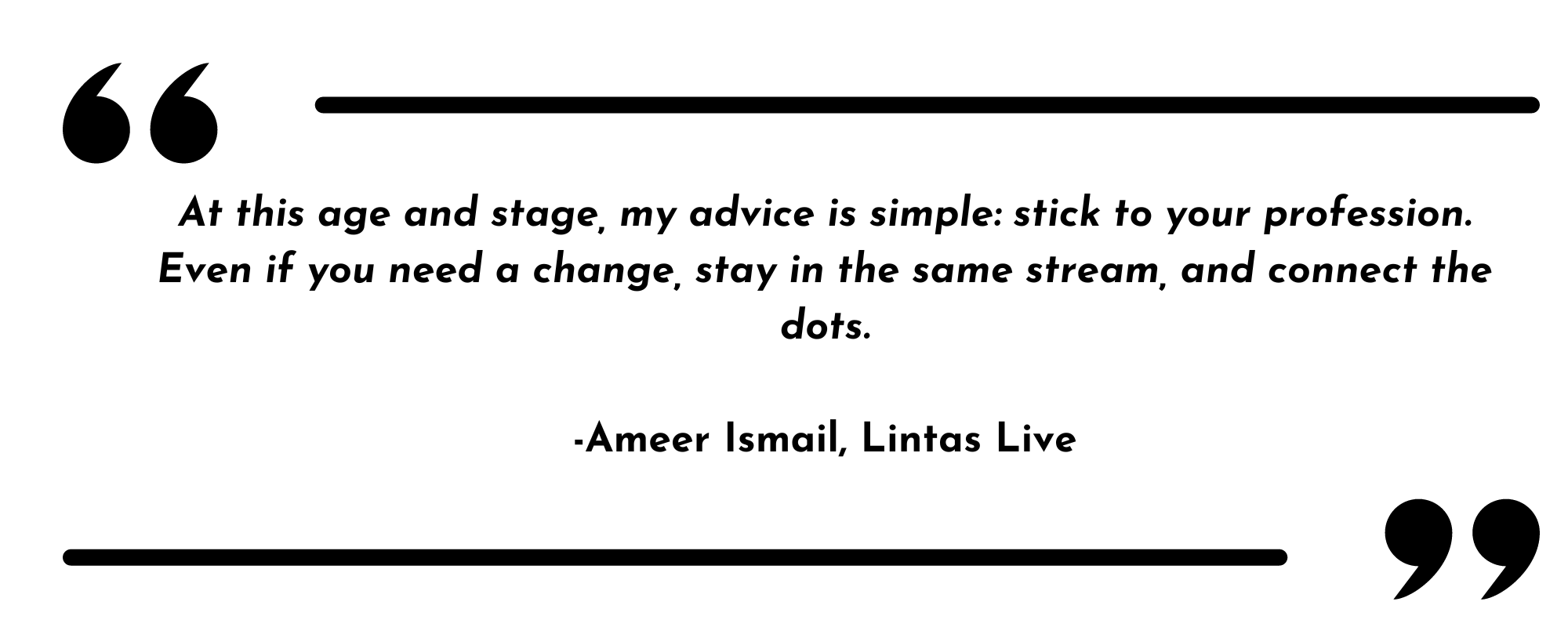
Lastly, for those entering the PR field, what unique piece of advice or encouragement do you have to offer as they embark on their professional journey?
At this age and stage, my advice is simple: stick to your profession. Even if you need a change, stay in the same stream, and connect the dots. Many people get bored easily. I’ve spent 27 years in the same agency, despite offers and numerous opportunities to explore other paths. Even today when I can afford to do nothing, I choose to get up every morning, feel motivated, and come to work because I love what I do. So, my advice is stick with it, and stay committed. Over time, you will achieve success and professional growth.
MediaRadar Acquires Vivvix, Kantar Group’s North American Advertising Intelligence Unit
MediaRadar, a platform for sales enablement and advertising intelligence, announced the acquisition of Vivvix, the North American Advertising Intelligence Unit of Kantar Group for an undisclosed sum. Vivvix provides competitive ad intelligence through digital and traditional media channels by utilizing artificial intelligence. These consist of social media, streaming services, and mobile apps. With this ground-breaking agreement, MediaRadar will be positioned as the go-to source for advertising data and insights, catering to the needs of media owners, agencies, and brands throughout the whole industry ecosystem.
AI-powered Advertising Intelligence Platforms
Artificial intelligence powers MediaRadar and Vivvix, to track and gather advertising insights across media and channels. AI also powers them for prospecting and sales recommendations. Transparency, trust, and high-quality data are more important than ever as the advertising sector develops and innovates with new formats for both established and emerging platforms. These insights guide decisions in ad sales, brand strategy, and media planning and buying, helping media companies, brands, and agencies navigate increasing fragmentation and complexity.
MediaRadar’s acquisition of Vivvix, the advertising intelligence unit
MediaRadar’s data capabilities are strengthened with the acquisition of Vivvix, along with its complementary channel coverage. This is by adding new categories like local TV, radio, and search along with expanding into Out-of-Home (OOH) advertising and the Canadian market. When MediaRadar is combined into a single platform, it will provide the most extensive near-real-time ad intelligence out there. Decisions about ad sales, brand strategy, and media planning and buying can be based on the data gathered by Vivvix and MediaRadar.
Read More: Microsoft Advertising and Media.Monks Unlock New Opportunities in China
Extensive client database
MediaRadar’s vast database tracks over $200 billion in annual media spend across over 4 million brands. It is relied upon by over 20,000 clients. A media budget of over $250 billion is covered by Vivvix’s advertising intelligence footprint. Brands, agencies, and media sellers rely on these platforms collectively to deliver ad intelligence that is essential to their primary business strategy. After the deal, MediaRadar will have more money and resources to invest in cutting-edge tech and data. It will assist it in developing next-generation solutions that maximize value for its clients. Furthermore, it will solidify its leadership in the analytics space.
Here’s what they said
Todd Krizelman, CEO and co-founder of MediaRadar said,
By combining Vivvix and MediaRadar, we offer a complete view of the entire advertising industry. Together, our unparalleled market intelligence will enable strategic decision-making, allowing media sellers, brands, and agencies to navigate the dynamic advertising landscape with even greater confidence.
Andrew Feigenson, CEO of Vivvix added,
When we launched Vivvix earlier this year, our mission was to become the world’s leading ad intelligence company. In joining forces with MediaRadar, we take a significant step toward that goal. We are incredibly excited to work with Todd and his team to achieve a common vision and deliver a complete view of the market to media companies, marketers, and agencies.
Chris Jansen, Chief Executive, Kantar stated,
Today’s transaction brings Vivvix together with a highly complementary business that goes a long way to delivering on their vision of building the most future-facing advertising intelligence business in North America. We’re excited about the possibilities that emerge from the combined entity and wish the Vivvix and MediaRadar team well on the next phase of their growth journey.
Read More: Yahoo Advertising Launches New Suite of Premium Ad Formats Edge-2-Edge
SRMG, Warner Bros. Discovery Launch Free-to-View Arabic Language Platform
Asharq Discovery, a new free-to-view Arabic language infotainment platform, has been unveiled by SRMG, the largest integrated media group from the MENA region, in collaboration with Warner Bros. Discovery. The platform began operations in Riyadh, Saudi Arabia. Asharq Discovery offers free access to top-notch international material in Arabic. It will feature hundreds of hours of high-quality content from Discovery’s lauded library in addition to hand-selected acquisitions from all over the region. Additionally, it features a compelling selection of creative creations.
The new free-to-view platform in MENA
The development of the new free-to-view platform is a direct response to the growing demand for Arabic-language content as well as shifting viewer tastes. According to a recent SRMG survey, more than 80% of Middle East and North Africa viewers are hungry for more Arabic programming. The site will provide a wide selection of genres while catering to a local audience. Pop science and engineering, crime and mystery, automobiles, travel and adventure, cuisine and cookery, wildlife and nature, lifestyle, and reality will all be covered.
SRMG – Warner Bros. Discovery Partnership
The partnership will produce believable and captivating MENA-related stories. Furthermore, because production will take place there, it will present opportunities for local talent. In order to showcase regional storytelling to a worldwide audience, WBD also has the option of globally distributing co-produced content through Warner Bros. Discovery channels and services. A long-term strategic alliance between SRMG and Warner Bros. Discovery led to the creation of Asharq Discovery. In addition to SRMG’s rights to choose content from Warner Bros. Discovery library, this partnership will feature the co-production of up to 30 hours of content each year with WBD and HBO.
Asharq Discovery
Exclusive programs from the acclaimed Warner Bros. Discovery’s library are featured on Asharq Discovery. Favorite shows from networks including Discovery, Animal Planet, TLC, Investigation Discovery, HGTV, Food Network, and regional favorites Fatafeat are among them. Arabic voiceovers and graphics have been added to the chosen programs in their entirety. Asharq Discovery’s initial schedule features free, never-before-seen Arabic television programs. They are Wheeler Dealers, Through the Wormhole with Morgan Freeman, Gold Rush, and 90 Day Fiancé.
Read More: Meta and Discovery+ Adjust Ad-Free Subscription Plans: Changes Ahead!
SRMG’s partnership portfolio
Bloomberg Media, The Independent Group, and Billboard are just a few of the notable companies that SRMG has a proven track record of working with successfully. Asharq Discovery is the most recent addition to SRMG’s award-winning “Asharq News Network,” which also includes Asharq News, Asharq Business with Bloomberg, and the recently launched Asharq Documentary, which offers incisive and factual documentary programming. These news outlets have been among the fastest-growing in the MENA region for the past three years. Through satellite coverage on Arabsat and Nilesat, the catch-up service Asharq NOW, and Asharq Discovery’s social media platforms, Asharq Discovery is available for free viewing throughout the area.
Here’s what they said
Jomana R. Al-Rashid, CEO of SRMG said,
Asharq Discovery’s launch is a direct response to the growing demand and changing consumption habits. We can see from several studies that there is an increase in the demand for audio and visual content across our region. The new free-to-view platform is the latest example of SRMG’s transformation strategy in action. At SRMG, we are dedicated to enhancing and expanding our media portfolio and elevating the media and entertainment ecosystem in the region. Just this past month, we launched Asharq Documentary, dedicated to uncovering the stories behind the headlines in politics, business and economics, and history. Now, with Asharq Discovery, we continue to redefine the viewing experience with seven distinct genres, each offering a fresh perspective on storytelling. The Asharq Discovery platform is unique as it provides a wide range of exceptional content in Arabic, and for the first time, for free. Our partnership with Warner Bros. Discovery is testament to our ambition to produce and showcase award-winning, authentic content that captivates and inspires audiences both here in our region and across the globe. The launch is just the start; we have extremely ambitious plans for co-production, and I look forward to watching the platform’s growth.
Jamie Cooke, GM CEE, Middle East & Turkey of Warner Bros. Discovery added,
The entertainment industry in the MENA region is an area of major global talent and transformative growth. We have seen immense changes over the last few years, and MENA audiences are eager for fresh and new content. I am excited to start developing Arabic content that can inspire viewers not just in the region but Arabic speaking audiences around the world. Warner Bros. Discovery has the greatest and broadest collection of brands, franchises, and storytelling IP in the world, and we’re excited to provide a new free-to-view channel where we can reach new audiences and bring them our stories through our partnership with SRMG.
Read More: SRMG Ventures Pours $5 Million in MENA’s Anghami Platform
Havas Invests in Uncommon Studios in A Bold Pledge to Creativity
Havas Media, a Paris-based agency network, acquired a majority stake of 51% in UK’s Uncommon Creative Studio. Havas is a relatively small agency compared to the big six agencies with respect to revenue and workforce. Hence, this acquisition is a breakthrough for them. Founded in 2017, Uncommon Creative Studio is the UK’s most award-winning and rapidly growing independent creative agency. They have already garnered the attention of some of the world’s largest and most prominent companies.
Massive news. So proud to welcome one of the best independent creative agency in the world @uncommon_LDN to the Havas family!@donna_murphy @nilsleonard @LucyJameson_ @nattergraeme https://t.co/1NnwElX90R
— Yannick Bolloré (@YannickBollore) July 12, 2023
As part of its commitment to foster creativity, Havas signed this deal to invest in significant brands. The deal also reflects their business methodology and values future potential at £80-120 million considering Uncommon Studio’s growth projections. Uncommon will preserve its brand, vision, and freedom in decision-making across its clients, partners, internal teams, and productive turnout. Management will retain a 49% material stake in the business, maintaining entrepreneurial zest. As a result, it will allow them to expand the brand globally, and share best practices across Havas and its parent company, Vivendi.
Yannick Bolloré, Chairman and CEO, Havas stated,
Uncommon will bring new energy, creativity, and audiences into Havas’ already leading-edge creative network, igniting, inspiring, and supporting every aspect of creativity.
He also added,
Uncommon have created a new space and energy in the industry. They are a once-in-a-decade company and having them join the Havas family is an exciting prospect.
Uncommon previously rejected deals proposed by other agencies. Nils Leonard, one of the three founders of Uncommon said,
This deal is different: it relies on freedom of choice, the ability to break down barriers, and the removal of dependency. We can create the industry we wish we worked in.
International Exposure for Uncommon Creative Studio
The London-based creative agency boasts a high clientele in the UK including ITV and British Airways. The agency has recently received the prestigious Cannes Lions Grand Prix for “A British Original Billboard campaign” designed for British Airways. They have twice been named UK’s Creative Agency of the Year and International Agency of the Year by Ad Age.
Additionally, Uncommon hosts an extensive list of clientele in the U.S. This was attainable because of their diversified and global mentality, reputation for creativity, and distinctive studio style. As a result, the Uncommon-Havas deal will boost the former’s international expansion plans.
Uncommon Creative Studios will also enjoy collaborating with Havas’ strong network and top-notch entertainment brands. They will also be in a position to work with leading companies like Universal Music Group, Gameloft, and Canal+ with this partnership
The Advertising Industry Scenario
Most agencies are scrambling to propose contracts with data and technology-focused companies. The ad industry is determined to leverage artificial intelligence to reduce expenses and increase momentum. Forrester reports that by 2030, ad agencies will automate 7.5% of their jobs.
Amidst all this, Havas has placed importance on the human creativity aspect of the industry. As such, this acquisition comes in as a ray of hope for creative agencies. Uncommon Creative Studios has 169 employees working under them. The company also does not plan to lay off anyone in the near future or because of the deal. Instead, they plan to hire qualified staff for their U.S. office. Uncommon is estimated to be worth £156 million by 2030 with this deal. As a result, this deal would make Uncommon one of the most successful creative agency start-ups in the UK.
Read More: PubMatic Takes On DSPs in Video & CTV Deals, Aims for Direct Access

